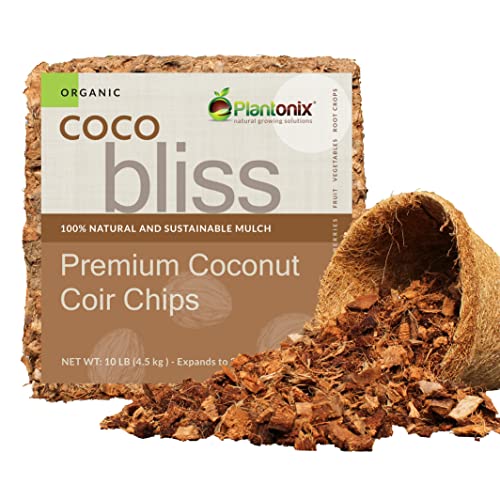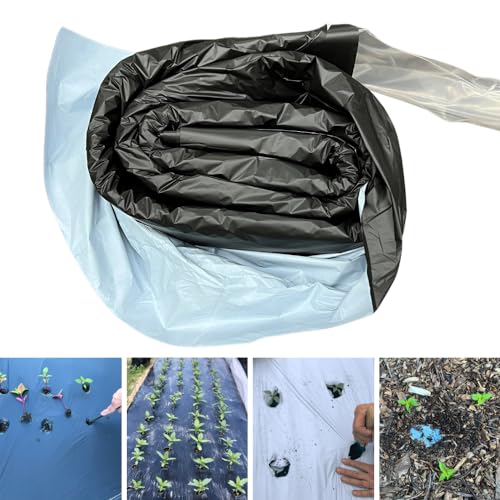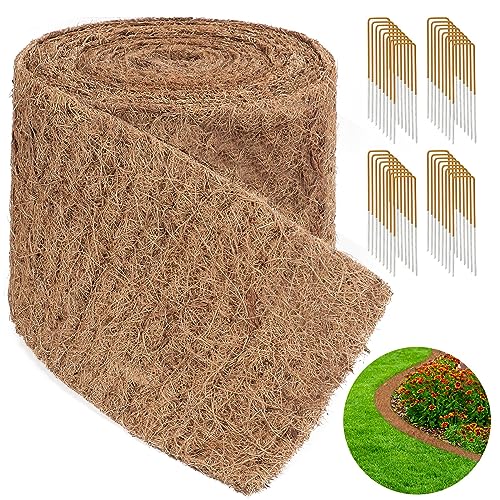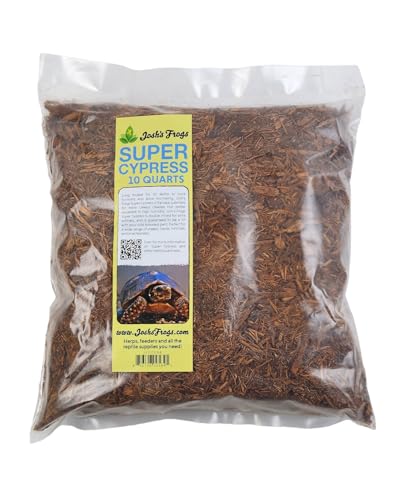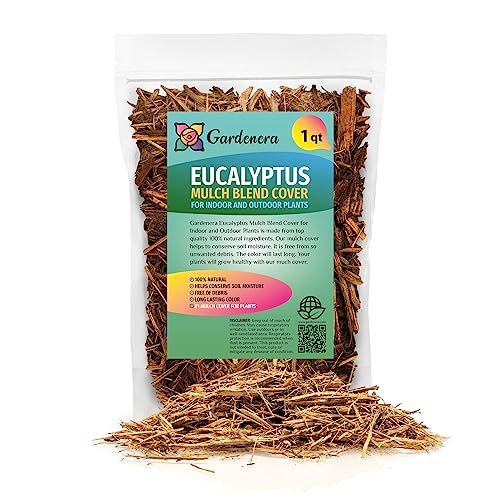Container plants in Florida can lose up to 2-3 times more water than their ground-planted counterparts due to increased evaporation and heat absorption. Learning the right way for watering container plants in your Florida garden is the first step to success.
Florida’s relentless sun and unpredictable weather patterns make container gardening both a rewarding challenge and a frustrating puzzle.
Whether you’re a seasoned gardener battling another scorching summer or a newcomer wondering why your beautiful potted plants keep wilting, we’ll help you learn the tricks to watering container plants in Florida’s erratic weather patterns.
From understanding Florida’s unique microclimates to mastering the delicate balance between drought stress and root rot, we’ll cover everything you need to create a thriving container garden that can handle whatever Mother Nature throws your way.
Understanding Florida’s Unique Climate Challenges for Container Plants

Florida’s diverse gardening zones create distinct watering challenges that every container gardener must navigate. From the subtropical conditions of North Florida to the tropical climate of the Keys, understanding your specific Florida microclimate gardening requirements is essential for success.
Climate Zones and Their Impact
Florida climate gardening spans three main zones, each presenting unique obstacles for potted plants.
North Florida experiences occasional freezes and more defined seasons, while Central and South Florida maintain year-round warmth with intense summer heat. And lately, the whole state has suffered under hotter summers and drier winters than ever before.
Container Material Effects on Water Retention

The choice of container material dramatically affects watering plants in the Florida heat. Terracotta and unglazed ceramic pots allow rapid evaporation, requiring more frequent watering but preventing root rot.
Plastic containers retain moisture longer but can overheat roots during Florida’s scorching summers. Dark-colored containers absorb more heat, accelerating water loss and potentially damaging root systems.
Humidity, Rainfall, and Temperature Fluctuations
Florida’s high humidity creates a deceptive environment where watering plants in the Florida humidity becomes tricky. While the air feels moist, container soil can dry rapidly due to intense sun and wind exposure.
The state’s erratic rainfall patterns mean Florida rain garden containers may receive inches of water one day, then face drought conditions for weeks.
Summer temperatures regularly exceed 90°F, with container plant heat stress becoming a major concern. Containers can reach soil temperatures of 120°F or higher, cooking roots and causing rapid moisture evaporation.
This extreme heat makes watering container plants in summer a daily necessity rather than a weekly chore.
Seasonal Variations Throughout the Year
Florida gardening seasons differ significantly from traditional four-season climates in temperate zones. The rainy season (May-October) brings afternoon thunderstorms and high humidity, while the dry season (November-April) features lower humidity and minimal rainfall.
Container plants require adjusted watering schedules that account for these seasonal variations – more frequent watering during dry months and careful drainage management during the rainy season.
Urban Heat Island Effects
Major Florida cities like Miami, Orlando, and Tampa create urban heat island effects that intensify watering challenges. Concrete and asphalt surfaces reflect and absorb heat, raising ambient temperatures by 5-10°F above surrounding areas.
Container gardens on patios, rooftops, and balconies face even more extreme conditions, requiring strategic placement and enhanced watering protocols to combat the additional heat stress.
Essential Watering Techniques for Florida Container Gardens
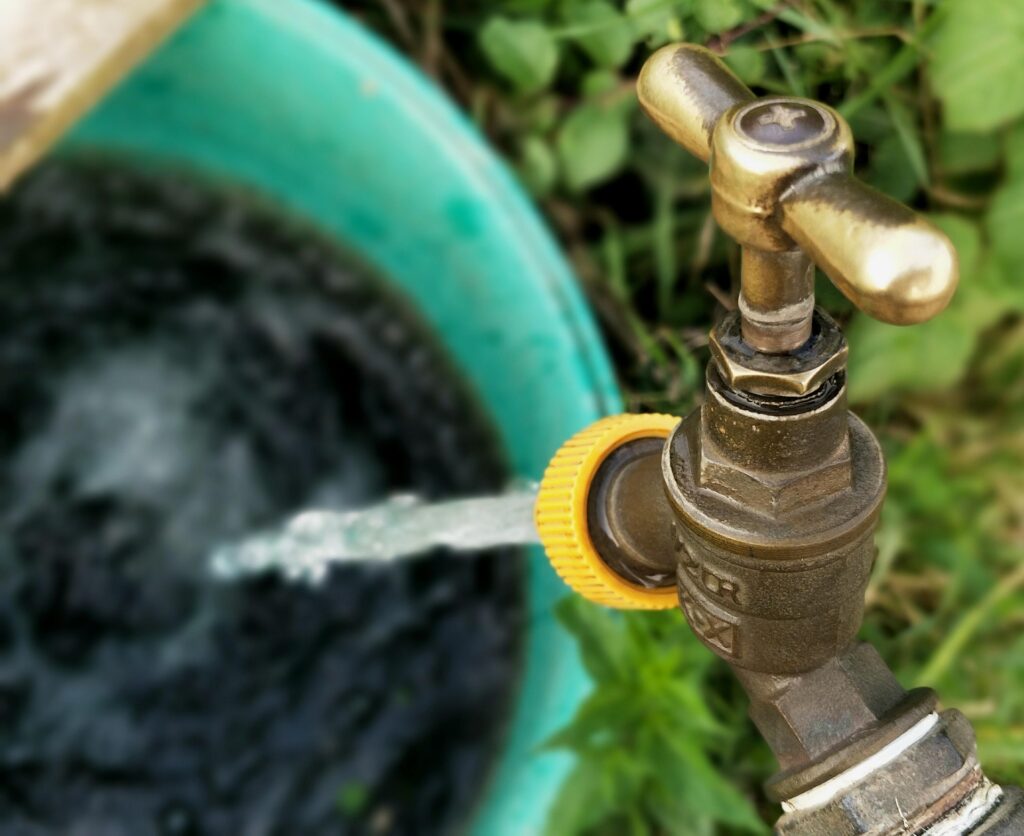
Mastering proper watering techniques in hot weather is crucial for successful Florida container gardening. These proven methods will help you maintain healthy plants while conserving water and preventing common problems such as root rot and heat stress.
Deep Watering vs. Frequent Shallow Watering
While in-ground plantings require more frequent watering due to the sandy nature of Florida soil, deep watering is the gold standard for watering container plants. Gardeners have the option of using a more retentive soil mix than found in the landscape. So, instead of daily light sprinkles, water thoroughly until you see drainage from the bottom holes.
This technique encourages roots to grow deeper into the container, creating a more resilient plant that can better handle Florida’s heat.
How to deep water effectively:
- Water slowly until liquid flows from the drainage holes
- Allow 10-15 minutes between watering sessions for soil absorption
- Check that water reaches the entire root zone, not just the surface
- Schedule deep watering 2-3 times per week rather than daily light watering
Shallow watering creates weak, surface-level roots that quickly dry out in hot conditions. This common mistake leads to constant wilting and increased water dependency.
The Finger Test and Moisture Assessment Techniques
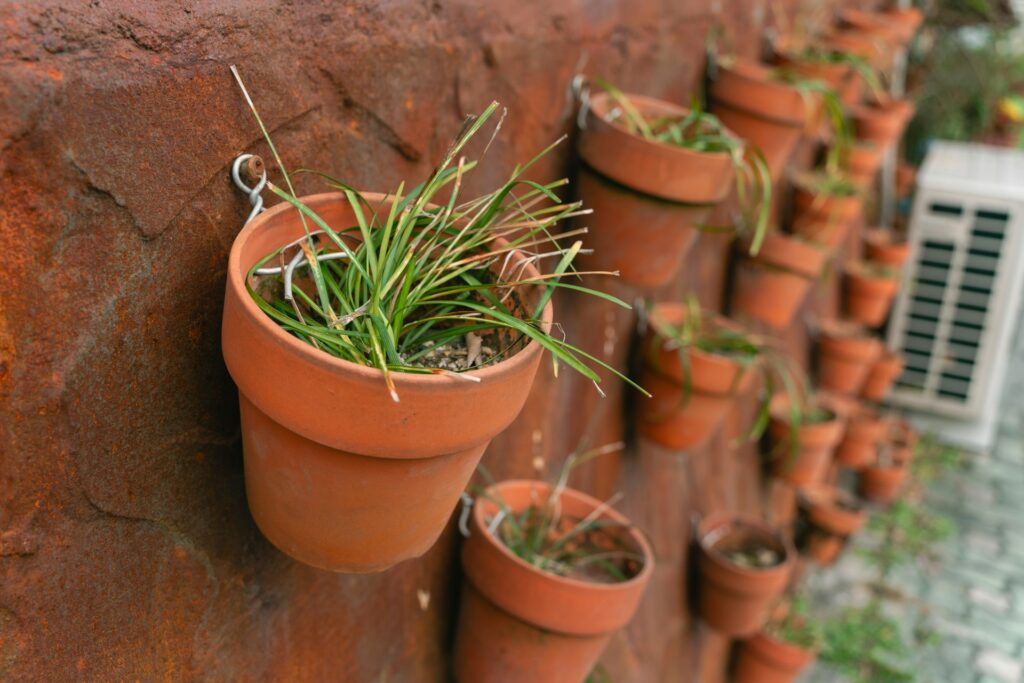
The finger test remains the most reliable method for determining container plant water requirements. Insert your finger 1 to 2 inches deep into the soil. If it feels dry at this depth, it’s time to water. For Florida herb containers and smaller pots, check at 1 1-inch depth.
Advanced moisture assessment methods:
- Wooden skewer test: Insert a clean skewer to the bottom of the pot. Moist soil will cling to the wood
- Container weight method: Lift containers to gauge moisture levels – dry pots feel significantly lighter
- Soil color check: Dark, moist soil versus light, dry soil provides visual moisture cues
- Digital moisture meters: Affordable tools that provide precise readings for multiple containers
Optimal Watering Timing
The Watering schedule for container plants in Florida requires strategic timing to minimize evaporation and maximize plant uptake. The best times are early morning (6-8 a.m.) and late evening (after 6 p.m.) when temperatures drop and humidity rises.
Morning watering advantages:
- Plants have all day to absorb moisture before the heat peaks
- Reduces fungal disease risk by allowing foliage to dry quickly
- Prepares plants for the day’s heat stress
- Maximizes water efficiency with lower evaporation rates
Evening watering considerations:
- Provides overnight moisture replenishment
- Helps plants recover from daily heat stress
- Requires careful attention to avoid overwatering in humid conditions
Avoid midday watering between 10 a.m. and 4 p.m., when watering plants in the Florida heat becomes inefficient due to rapid evaporation.
Bottom Watering vs. Top Watering Approaches

Bottom watering excels for container plants prone to crown rot or fungal issues. Place containers in saucers filled with water, allowing the soil to absorb moisture from below through drainage holes.
Bottom watering technique:
- Fill saucers with 1-2 inches of water
- Allow 30-60 minutes for absorption
- Remove excess water to prevent root rot
- Check soil moisture at the surface level to confirm adequate uptake
Top watering works best for most Florida container vegetables and larger plants. Water directly onto the soil surface, avoiding foliage when possible.
Top watering best practices:
- Use a watering wand or gentle spray setting
- Apply water slowly to prevent soil erosion
- Focus on soil, not leaves, to reduce disease risk
- Water until drainage occurs from the bottom holes
Managing Watering During Florida’s Rainy Season
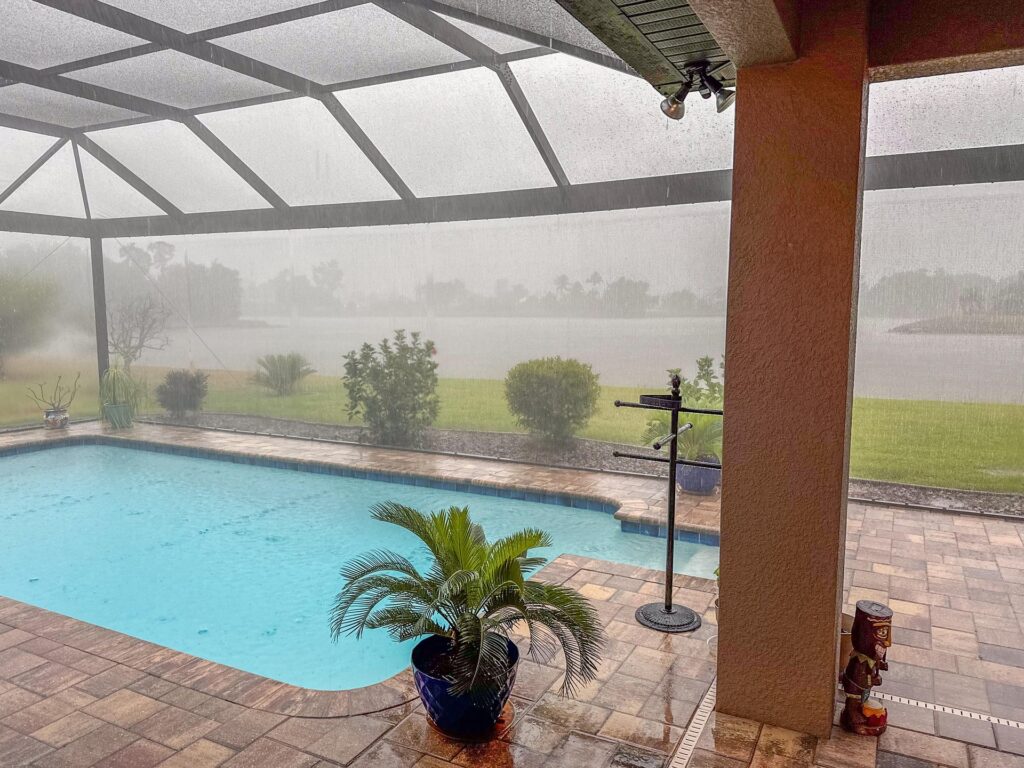
Florida garden containers face unique challenges during the wet season (May through October). Excessive rainfall can quickly lead to waterlogged soil and root rot, making watering container gardens more about drainage management than moisture addition.
Rainy season strategies:
- Monitor daily rainfall using rain gauges or weather apps
- Elevate containers on bricks or pot feet to improve drainage
- Cover or move sensitive plants during heavy downpours to prevent oversaturation
- Adjust watering schedules based on recent precipitation
- Check drainage holes regularly to ensure they’re not clogged
Overwatering prevention during wet periods:
- Skip scheduled watering after receiving 1+ inch of rainfall
- Test soil moisture more frequently during rainy spells
- Move containers under covered areas during extended wet periods
- Use well-draining soil mixes designed for florida climate gardening
Plants That Need Protection From Overwatering
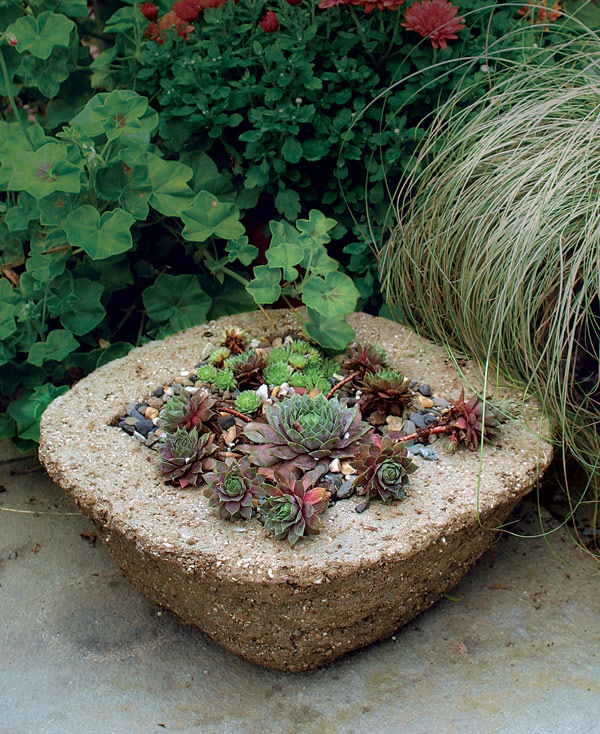
Certain Florida herb containers and popular container plants are particularly susceptible to root rot during the rainy season and should be moved under covered areas:
Mediterranean herbs and drought-tolerant plants:
- Rosemary – extremely sensitive to wet feet and humid conditions
- Lavender – requires excellent drainage and hates soggy soil
- Oregano and thyme – prone to fungal issues in wet conditions
- Sage – develops root rot quickly in oversaturated soil
Succulent and cacti varieties:
- Aloe vera – store water in leaves and need minimal additional moisture
- Jade plants – rot rapidly in consistently moist conditions
- Barrel cacti – designed for arid conditions, not Florida’s wet season
Other vulnerable container plants:
- Citrus trees – susceptible to foot rot and fungal diseases
- Geraniums – develop black leg disease in wet conditions
- Begonias – prone to stem rot when overwatered
Move these plants to covered patios, porches, or temporary shelters during extended rainy periods to maintain proper container plant care.
Understanding Florida Climate Soil Mixes
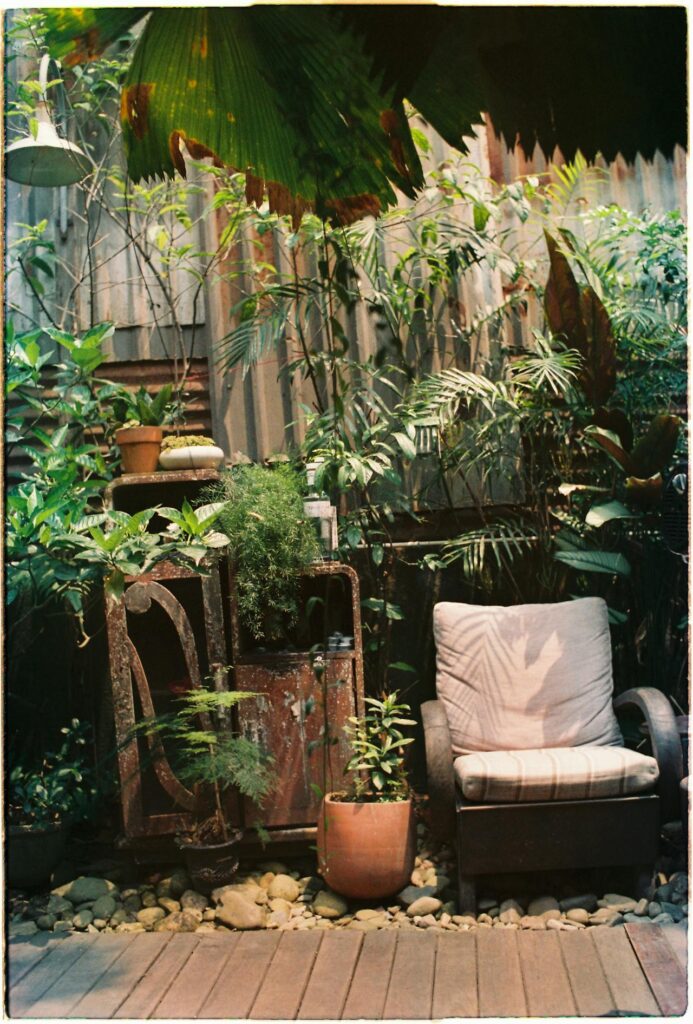
Soil mixes designed for Florida container gardening must balance moisture retention with rapid drainage. Standard potting soil often retains too much water for Florida’s humid conditions.
Key components to look for:
Drainage materials (30-40% of mix): Perlite, vermiculite, bark chips/nuggets, and coarse sand.
Organic matter (40-50% of mix): Aged compost, coconut coir, aged pine bark, and leaf mold.
Soil amendments (10-20% of mix): Worm casting, composted manures, and biochar.
Pre-made options for Florida: Look for potting mixes labeled “cactus and succulent,” “Mediterranean herbs,” or “fast-draining” rather than standard potting soil. Look for brands like Miracle-Gro Cactus Mix for drought-tolerant and Mediterranean plants.
Espoma Organic Potting Mix or FoxFarm Ocean Forest work well for other Florida container plants.
Quick drainage assessment: If standing water remains on the soil surface 5 minutes after rain stops, your containers need better drainage or a different soil mix.
These watering techniques form the foundation of successful water-wise container gardening in Florida’s challenging climate. Master these methods, and you’ll see immediate improvements in plant health and water efficiency.
Choosing the Right Containers and Soil for Optimal Water Management
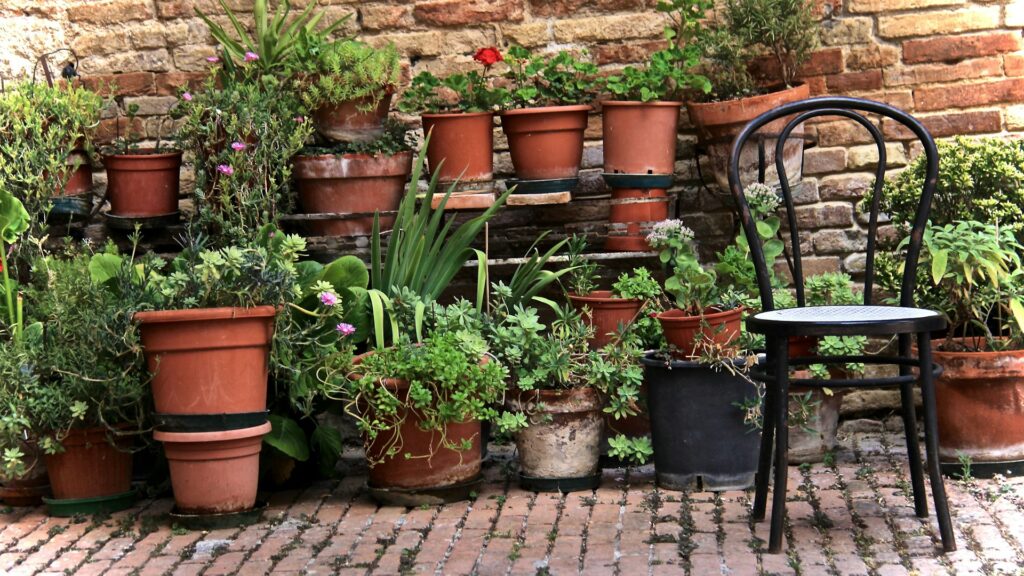
The foundation of successful watering container plants in Florida starts with selecting appropriate containers and soil. Your choice of container plant soil and pot materials directly impacts how often you’ll need to water and how well your plants will thrive in Florida’s challenging climate.
Container Material Basics
Container gardening supplies for Florida should prioritize materials that balance water retention with heat protection.
Plastic containers retain moisture longer but can overheat roots, while terracotta provides excellent drainage but requires more frequent watering.
Dark containers absorb heat and accelerate water loss, making light-colored options preferable for Florida container gardening.
Essential Drainage Requirements
Proper drainage holes are non-negotiable for Florida container gardening. Without adequate drainage, even the best watering techniques in hot weather won’t prevent root rot during Florida’s humid conditions.
Containers need multiple holes, not just one central drain.
Self-Watering Systems
Self-watering containers for Florida garden containers can help maintain consistent moisture levels, but choose systems with adjustable water flow to prevent oversaturation during the rainy season.
For comprehensive guidance on selecting the best containers, check out our detailed guide here.
Revolutionary Soil Amendments and Water-Saving Technologies for Florida Containers
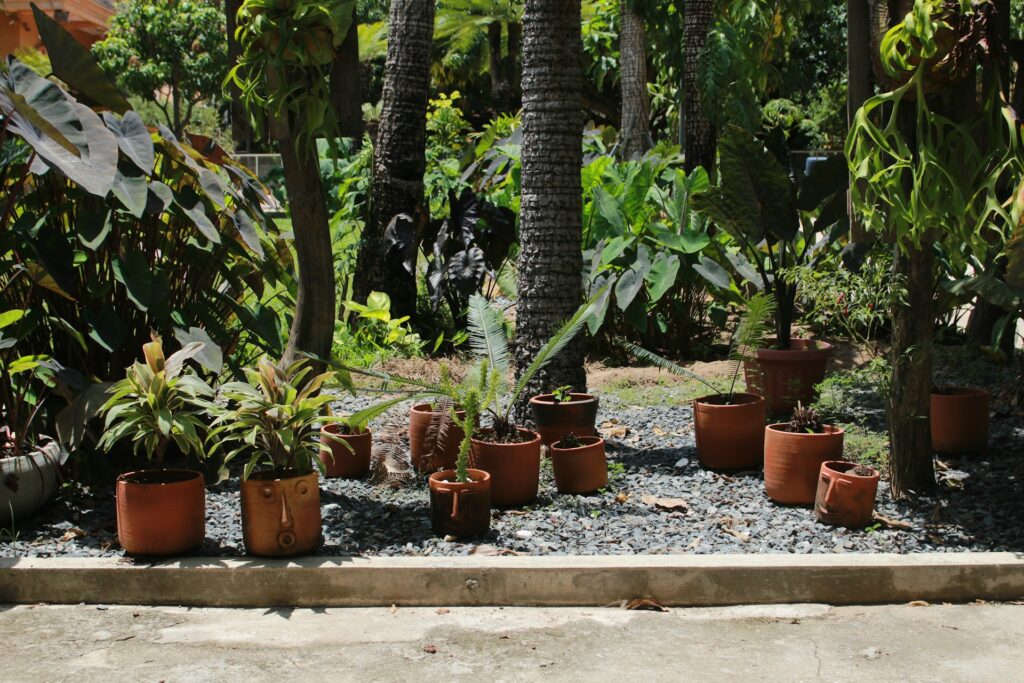
Modern water-saving soil additives have revolutionized Florida container gardening by addressing the unique challenges of maintaining adequate soil moisture in extreme heat while preventing waterlogged conditions during rainy periods.
These innovative sustainable soil amendments combine cutting-edge materials science with practical gardening applications to create more resilient growing environments.
Hydrogel Crystals and Polymer-Based Water Retention Products
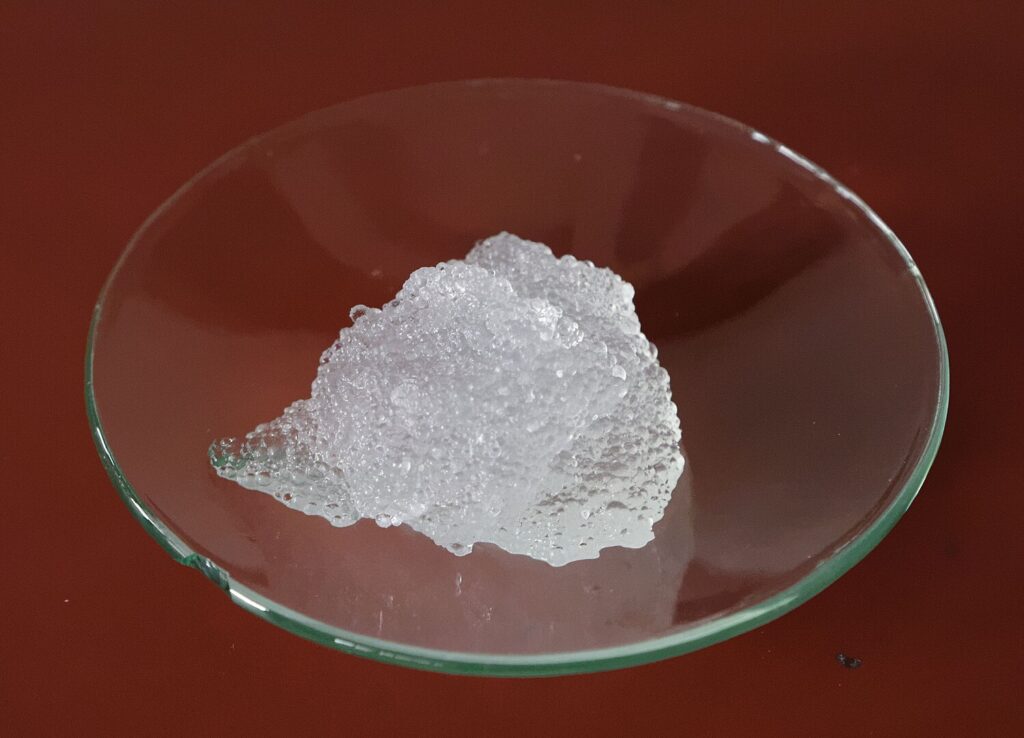
Hydrogel crystals water retention technology represents one of the most significant advances in container soil technology.
These super-absorbent polymers (SAPs) are typically made from cross-linked polyacrylamide or polyacrylate compounds that can absorb 200-400 times their dry weight in water, creating a reservoir that releases moisture gradually as soil dries.
Polymer water crystals excel in Florida container gardening scenarios where consistent moisture is critical but daily watering isn’t feasible.
They’re particularly beneficial for vacation watering, large containers that dry out quickly, and herb containers like basil and cilantro that need steady moisture.
The technology works exceptionally well during Florida’s dry season when humidity drops and containers lose moisture rapidly.
However, these products have limitations in Florida’s wet season. Excessive rainfall can cause hydrogels to swell, creating waterlogged conditions that promote root rot.
They’re also less effective in high-salt environments, as sodium and other salts can interfere with water absorption. Additionally, some drought-tolerant container plants (rosemary, lavender, succulents) may actually suffer from the consistent moisture these products provide.
Biochar Applications for Improved Water Holding Capacity
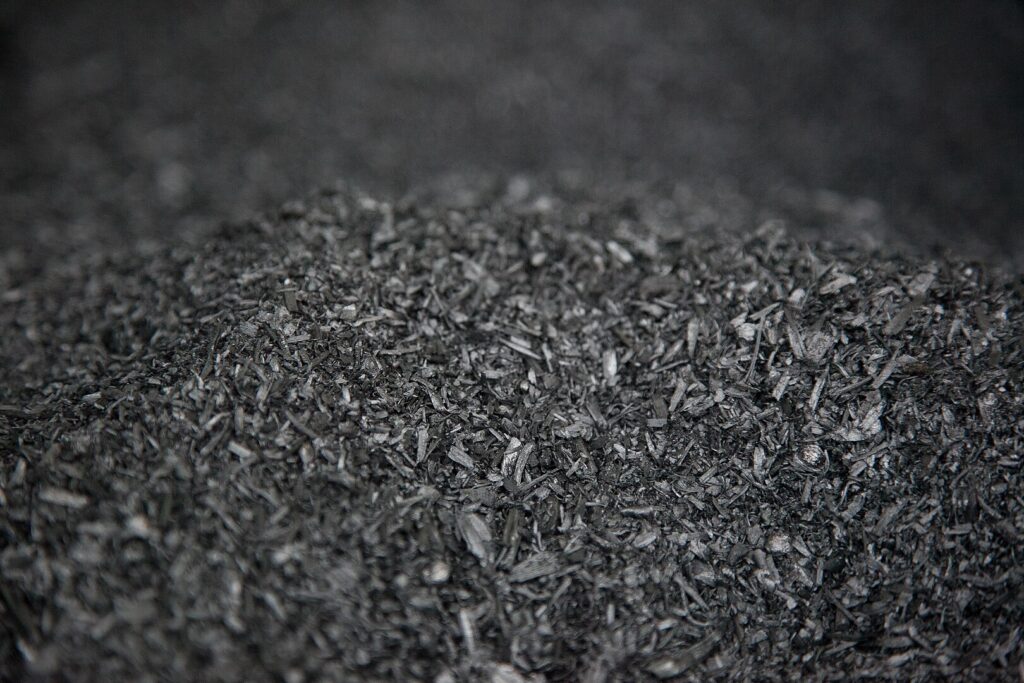
Biochar utilizes a carbon-rich material produced through pyrolysis – the controlled burning of organic matter (wood, agricultural waste, bamboo) in low-oxygen environments at temperatures between 300-700°C.
This process creates a highly porous, stable carbon structure with an enormous surface area – up to 300 square meters per gram – that excels at both water retention and nutrient storage.
The porous structure of biochar contains both macropores (larger spaces that provide drainage and aeration) and micropores (tiny spaces that hold water and nutrients). This dual-porosity system makes biochar ideal for Florida container gardening, where you need both good drainage during heavy rains and water retention during dry periods.
The material’s alkaline pH (typically 8-10) can also help buffer acidic Florida soils and provide slow-release minerals like potassium and calcium.
Biochar’s water-holding mechanism works through capillary action within its porous structure. Water molecules are held in the micropores through surface tension, creating a reservoir that plant roots can access as needed.
Studies show biochar can increase soil water retention by 15-20% while simultaneously improving drainage – a perfect combination for water-efficient soil products in Florida’s variable climate.
When to Use Biochar
This amendment particularly benefits Florida container vegetables like tomatoes, peppers, and eggplants that need consistent moisture but can’t tolerate waterlogged conditions.
It’s also excellent for Florida native container plants that have adapted to sandy soils with good drainage but benefit from enhanced water retention during dry spells.
Biochar is less beneficial for plants requiring very fast drainage, such as cacti and Mediterranean herbs.
It can also initially tie up nitrogen in the soil if not properly “charged.” Some lower-quality biochars may contain residual tars or chemicals from incomplete pyrolysis.
Look for products certified by the International Biochar Initiative (IBI) that specify feedstock source and production temperature.
Local sources may include facilities processing agricultural waste from Florida’s citrus or timber industries.
If you’re dedicated and have a lot of woody yard waste, you can even make your own biochar.
Coconut Coir vs. Peat Moss: Sustainable Moisture Retention Options

Coconut coir vs peat moss represents a critical choice for sustainable container gardening in Florida. Coconut coir, made from the fibrous husks of coconuts, offers superior performance in hot climates compared to traditional peat moss, which comes from slowly decomposing sphagnum moss in northern bogs.
Coir’s structure consists of lignin-rich fibers that resist decomposition and maintain their physical properties even in Florida’s heat and humidity. The material can hold 8-10 times its weight in water while maintaining excellent aeration – crucial for preventing root rot in Florida container gardens.
Unlike peat moss, which becomes hydrophobic (water-repelling) when it dries completely, coir readily re-wets and maintains consistent moisture-holding capacity throughout multiple wet-dry cycles.
The manufacturing process involves extracting long fibers from coconut husks, then processing the remaining material (called coir pith or coir dust) through washing, screening, and composting.
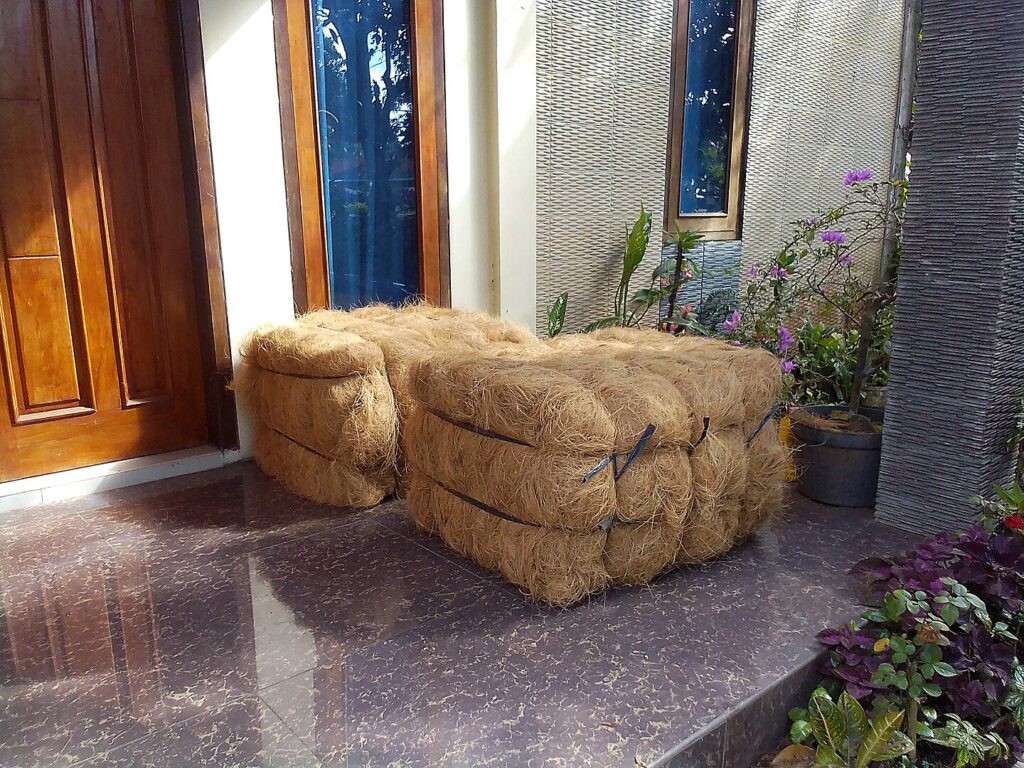
Coir excels in Florida container gardening applications where consistent moisture and good drainage are both required. It’s particularly beneficial for vegetables and flowering plants that need steady root-zone moisture.
The material’s natural antifungal properties also help prevent damping-off and root rot diseases common in Florida’s humid conditions.
However, coir provides minimal nutrition compared to peat moss and may require additional fertilizers. Some plants that prefer acidic conditions (blueberries, azaleas) may struggle with coir’s higher pH.
Quality coconut coir is available from lawn and garden centers and online. Some of my favorite brands are CocoBliss, GroMed, and Back to the Earth.
Look for products labeled “low EC” (electrical conductivity) indicating proper salt removal. Avoid products from questionable sources that may contain excessive salts or contaminants.
Perlite, Vermiculite, and Expanded Clay Pellets for Drainage Balance
Perlite and vermiculite container soil components serve different but complementary roles in creating optimal moisture retention products for Florida containers.
Understanding their distinct properties allows gardeners to customize soil mixes for specific plant needs and seasonal conditions.
Perlite
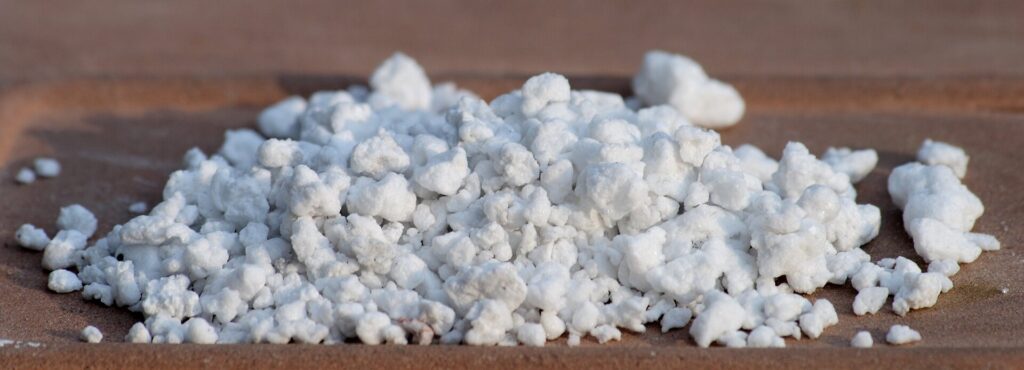
Perlite is created by heating volcanic glass (obsidian) to 1,600°F, causing trapped water to vaporize and expand the material into lightweight, white granules with numerous air pockets. This process creates a material that’s essentially neutral (pH 7.0) with excellent drainage properties and virtually no nutrient content.
Perlite’s structure provides permanent air spaces in soil mixes, preventing compaction while allowing excess water to drain quickly.
Vermiculite
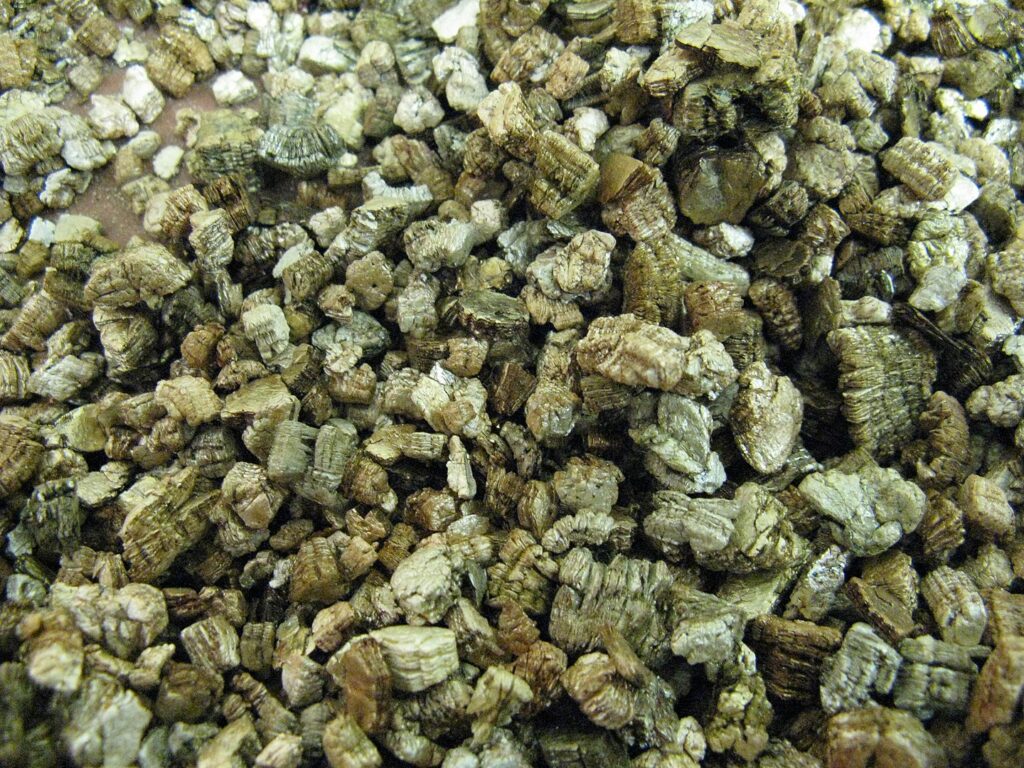
Vermiculite undergoes a similar heating process but starts with mica-based minerals. When heated to 1,800°F, water trapped between the mineral layers turns to steam, expanding the material into accordion-like structures.
Unlike perlite, vermiculite has significant cation exchange capacity, meaning it can hold and slowly release nutrients like potassium, magnesium, and ammonium. It also retains more water than perlite while still providing good aeration.
Vermiculite works better for Florida container vegetables and flowering plants that need consistent moisture retention alongside good drainage. Its nutrient-holding capacity makes it valuable in organic growing systems where slow nutrient release benefits plant health.
However, vermiculite can retain too much water for some applications and may contribute to overwatering problems in humid conditions.
Clay Pellets

Expanded clay pellets (hydroton or LECA – Lightweight Expanded Clay Aggregate) are manufactured by heating clay to 2,000°F in rotary kilns, creating round, porous balls with a hard outer shell and honeycomb interior.
This process produces a pH-neutral medium with excellent drainage and aeration properties that won’t break down over time.
In Florida container gardening, perlite excels in situations requiring maximum drainage – essential for drought-tolerant container plants and during Florida’s wet season.
It’s particularly beneficial in mixes for Mediterranean herbs, cacti, and succulents that prefer drier conditions. The material also helps prevent soil compaction in large containers that might otherwise become waterlogged.
Expanded clay pellets provide the best long-term drainage solution for permanent plantings like Florida native container plants or fruit trees. They don’t break down like organic materials and maintain consistent drainage properties for years.
The pellets are also excellent for creating drainage layers at container bottoms or for hydroponic applications.
These materials are widely available at garden centers and online suppliers. Look for horticultural grades rather than construction materials, which may contain unwanted additives.
New-Generation Soil Conditioners: Zeolite and Diatomaceous Earth
Zeolite and diatomaceous earth represent advanced soil amendment innovations that address specific challenges in Florida gardening through their unique mineral structures and properties.
Zeolite

Zeolite is a naturally occurring aluminosilicate mineral formed through volcanic activity over millions of years. The most common horticultural variety, clinoptilolite, has a crystalline structure with uniform pores measuring 4-7 angstroms in diameter – perfectly sized to trap and slowly release water molecules and nutrient ions.
This molecular sieve effect allows zeolite to hold up to 60% of its weight in water while maintaining excellent drainage properties.
The mineral’s cation exchange capacity (CEC) of 120-180 meq/100g far exceeds most soil amendments, meaning it can hold and gradually release essential nutrients like nitrogen, potassium, and calcium.
In container applications, zeolite acts as a nutrient buffer, preventing fertilizer burn during heavy feeding while ensuring steady nutrient availability during plant uptake periods.
Zeolite excels in Florida container plants that require consistent but not excessive moisture. It’s particularly beneficial for vegetable containers where nutrient retention and gradual release improve plant performance while reducing fertilizer runoff.
However, zeolite provides no organic matter or biological activity to soil mixes. It’s also relatively expensive compared to traditional amendments and may not be cost-effective for large-scale applications. Some plants requiring very acidic conditions might struggle with zeolite’s slight alkaline buffering effect.
High-quality zeolite is available from specialty suppliers like Rocky Mountain Zeolite and ZeopPro, typically costing $25-40 per 50-pound bag. Look for products specifying clinoptilolite content and particle size (3-8mm works well for containers). Avoid swimming pool or industrial zeolites, which may contain additives unsuitable for plants.
Diatomaceous Earth
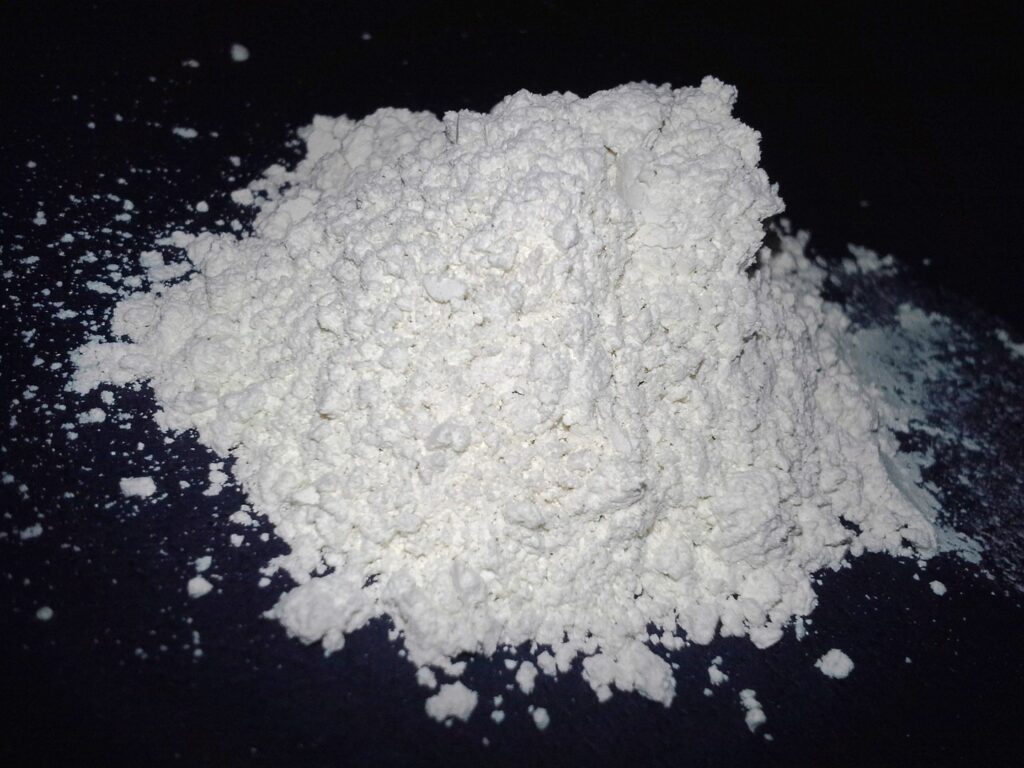
Diatomaceous earth (DE) consists of fossilized remains of diatoms – microscopic algae with silica-based cell walls. Food-grade DE contains 85-90% amorphous silica in the form of intricate, porous structures that can absorb 1.5-2 times their weight in water.
The material’s extremely fine particle size (10-200 microns) allows it to fill small spaces in soil mixes while providing unique properties.
DE’s water-holding mechanism relies on its massive surface area – up to 20 square meters per gram – created by countless microscopic pores in each diatom skeleton.
This structure creates capillary action that holds water molecules while allowing air movement through larger pore spaces. The material also provides slow-release silica, which strengthens plant cell walls and improves disease resistance.
In Florida container gardening, DE works exceptionally well for plants requiring consistent moisture with excellent drainage, such as orchids, bromeliads, and epiphytic plants native to Florida’s ecosystems.
It’s also valuable in seed-starting mixes where moisture retention without waterlogging is critical for germination success.
DE has limitations in heavy clay soils where its fine particles might contribute to compaction. It can also be messy to handle and may create respiratory irritation if inhaled. Some grades contain crystalline silica, which poses health risks – only food-grade DE should be used in gardening applications.
Smart Mulches: Reflective, Biodegradable, and Water-Permeable Options
Smart mulch technology represents the cutting edge of advanced mulching materials designed specifically for challenging climates like Florida’s.
These innovative products go beyond traditional organic mulches by incorporating engineered properties that actively respond to environmental conditions while providing superior water conservation benefits.
Reflective Mulch
Reflective mulch utilizes metallic or light-colored surfaces to reduce soil temperature while maintaining moisture. These mulches typically consist of plastic films with aluminum coatings, reflective stones, or specially treated organic materials that reflect 60-80% of incoming solar radiation.
The reduced soil temperature decreases evaporation rates by 20-30% compared to dark mulches, while the reflected light can improve photosynthesis in plant foliage.
Reflective mulches work exceptionally well for Florida container vegetables like tomatoes, peppers, and squash, where reduced soil temperature improves root health and reflected light enhances fruit production.
They’re particularly beneficial during Florida’s intense summer months when container soil temperatures can exceed 120°F. The technology also helps deter certain insect pests that are disoriented by reflected light.
However, reflective mulches can create glare issues in residential settings and may overstimulate some plants with excessive reflected light.
They also lack the organic matter benefits of traditional mulches and don’t improve soil structure over time. Installation requires careful attention to wind resistance, as lightweight films can blow away during storms.
Biodegradable Mulch
Biodegradable mulch on container plants addresses environmental concerns while providing superior moisture management.
These mulches are manufactured from materials like cornstarch, wheat straw, paper pulp, or other organic polymers that break down completely within 1-2 growing seasons.
Advanced formulations incorporate controlled-release properties that adjust decomposition rates based on soil temperature and moisture.
The manufacturing process involves creating films or mats from renewable resources, often incorporating water-retention additives like cellulose fibers or natural gums.
Some products include embedded seeds for cover crops that emerge as the mulch decomposes, creating living mulch systems that continue providing soil protection and moisture conservation.
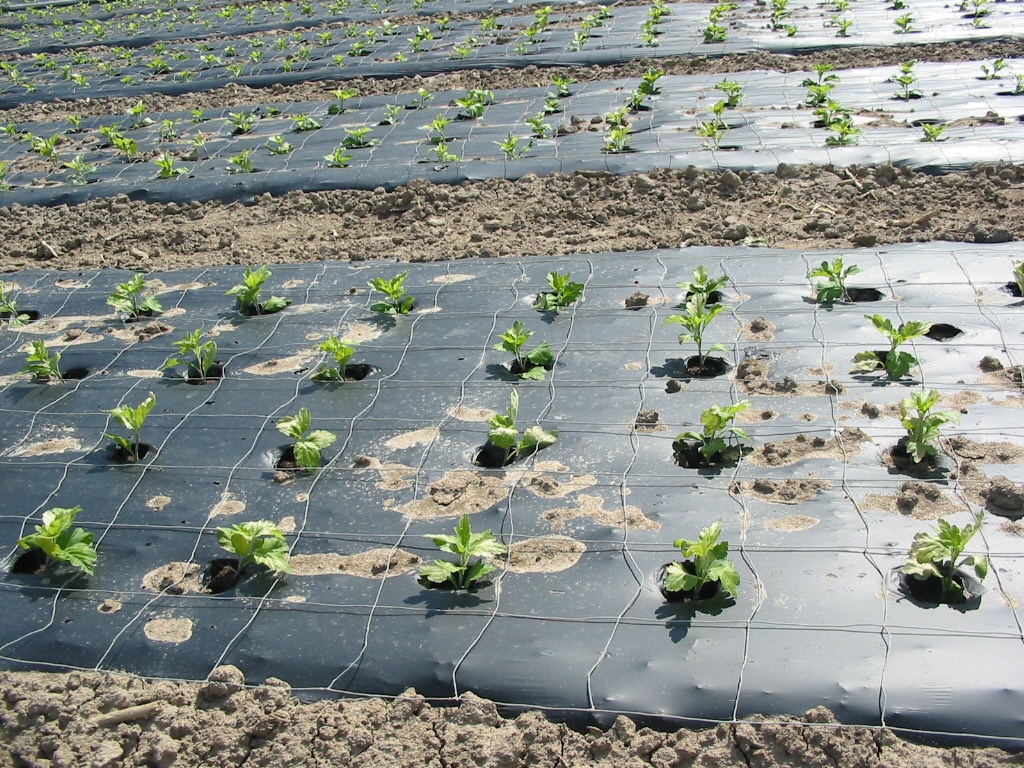
These mulches excel in annual container plantings where seasonal replacement aligns with the mulch decomposition schedule.
They’re particularly valuable for herb and vegetable containers where soil improvement from decomposing organic matter benefits plant health. The biodegradable nature eliminates disposal concerns and adds organic matter to soil mixes.
Limitations include potential premature breakdown during extended wet periods and possible nitrogen tie-up as organic materials decompose.
Some formulations may contain additives that affect soil chemistry or plant growth. Quality can vary significantly between manufacturers, with some products decomposing too quickly or too slowly for practical use.
Water Permeable Mulch
Water-permeable mulches provide excellent results for container plantings requiring precise moisture control, such as florida native container plants adapted to specific soil moisture ranges. They’re also valuable for automated irrigation systems where consistent moisture distribution is critical for plant health.
Mycorrhizal Fungi Inoculants for Enhanced Water Uptake Efficiency
Mycorrhizal fungi technology harnesses ancient plant-fungal partnerships to dramatically improve water uptake efficiency and overall plant resilience in Florida container gardening applications.
These beneficial fungi form symbiotic relationships with plant roots, extending the effective root system by 10-1000 times through microscopic fungal networks called hyphae.
The two primary types used in container gardening are endomycorrhizae (arbuscular mycorrhizal fungi or AMF) and ectomycorrhizae.
AMF penetrate root cells and form internal structures called arbuscules and vesicles, while ectomycorrhizae form external sheaths around root tips. For most Florida container plants – including vegetables, herbs, and flowering plants – AMF inoculants provide the greatest benefits.
The water uptake mechanism works through the fungi’s extensive hyphal networks that explore soil volumes far beyond plant roots’ reach. These microscopic threads, measuring only 2-5 microns in diameter, can access water in soil pores too small for root hairs to penetrate.
The fungi absorb water and transport it directly to plant roots through specialized structures, effectively expanding the plant’s water-gathering capacity exponentially.
Other Benefits
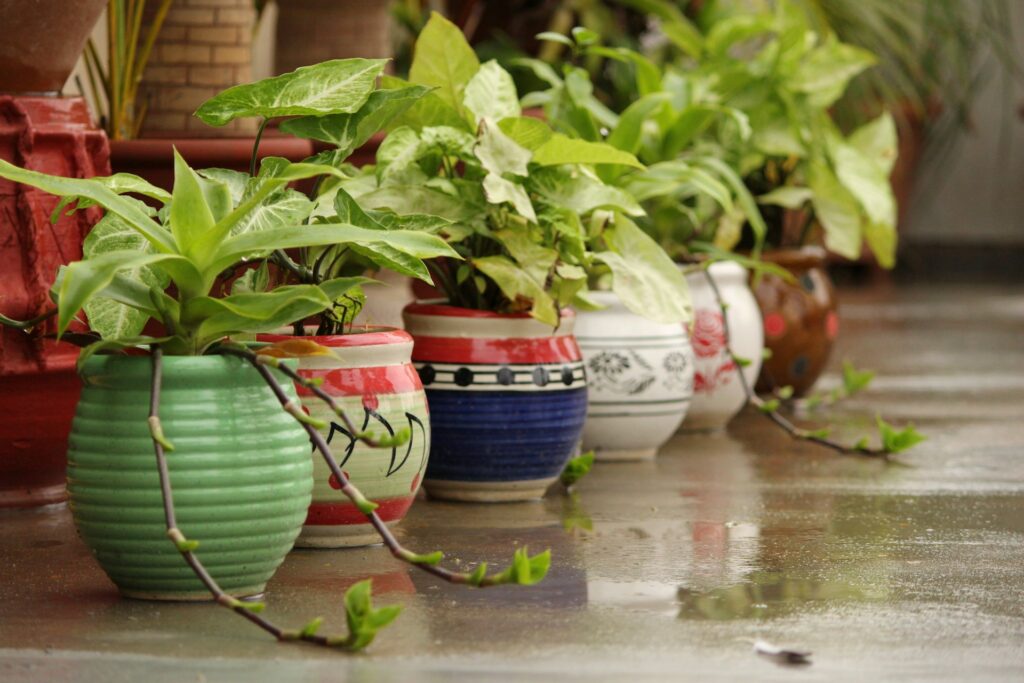
Mycorrhizal networks also improve drought tolerance through osmotic adjustment mechanisms. The fungi help plants accumulate compatible solutes (proline, glycine betaine, trehalose) that allow cells to maintain water content even under stress conditions.
Additionally, mycorrhizal plants often develop more extensive and efficient root systems, further enhancing water uptake capabilities.
Vegetables like tomatoes, peppers, and herbs often demonstrate 20-40% better drought tolerance when mycorrhizal partnerships are established.
The technology also improves nutrient uptake, particularly phosphorus, which is often limited in Florida’s sandy soils.
However, mycorrhizal inoculants have limitations and specific requirements. They don’t benefit plants in the Brassicaceae family (cabbage, broccoli, mustard) or other non-mycorrhizal species. High-phosphorus fertilizers can inhibit mycorrhizal establishment, requiring adjusted fertilization programs. The fungi also need 4-8 weeks to establish effective partnerships, providing no immediate benefits to newly planted containers.
Water-Absorbing Granules and Time-Release Watering Crystals
Advanced water-absorbing soil crystals and time-release watering crystals represent sophisticated polymer engineering designed to address the precise moisture management challenges of Florida container gardening.
These products go beyond basic hydrogel technology by incorporating controlled-release mechanisms, temperature responsiveness, and enhanced durability specifically engineered for extreme climate conditions.
Modern time-release crystals utilize cross-linked acrylamide copolymers with varying molecular weights and cross-link densities that create different water release profiles. The manufacturing process involves controlled polymerization with specific cross-linking agents that determine how quickly absorbed water is released back to plants.
Some formulations include thermoplastic components that adjust release rates based on soil temperature – releasing more water during hot periods and conserving moisture during cooler conditions.
The mechanism works through osmotic pressure differentials and polymer chain relaxation. As soil moisture decreases, the concentration gradient between the water-swollen polymer and surrounding soil increases, driving moisture release.
Organic Compost Blends for Florida’s Climate
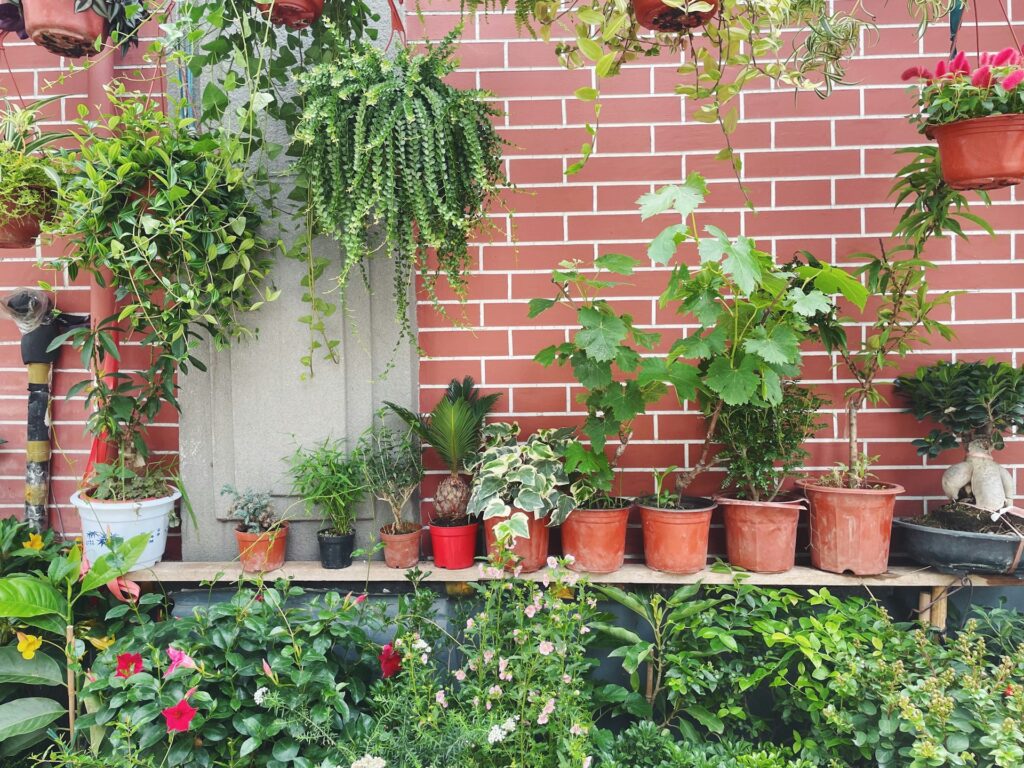
Florida container plants require compost formulations that address the unique decomposition challenges and nutrient cycling patterns of Florida’s hot, humid climate.
Standard compost blends often break down too quickly in Florida’s heat or create anaerobic conditions that promote harmful bacteria and fungi.
High-performance compost for Florida container gardening typically incorporates carbon-rich materials with varying decomposition rates to provide both immediate and long-term benefits.
The blend ratios are engineered to maintain organic matter content even as faster-decomposing components break down in Florida’s heat.
The water-holding mechanism in quality compost works through both physical and chemical processes. Physically, organic particles create numerous micropores that hold water through capillary action.
Chemically, humic and fulvic acids in well-aged compost can hold 20 times their weight in water while improving soil cation exchange capacity for better nutrient retention.
Advanced compost blends also incorporate mycorrhizal fungi, beneficial bacteria, and other soil microorganisms that enhance water uptake efficiency and plant health.
These biological components are particularly valuable in container applications where natural soil ecosystems don’t develop automatically.
These specialized composts excel in Florida container gardens for consistent organic matter replenishment, such as heavy-feeding vegetables, annual flowers, and herbs.
They’re also valuable for long-term container plantings where gradual organic matter release supports sustained plant health without frequent soil replacement.
Generally, however, you’re better off making your own compost from available yard waste and weed clippings. You know where it came from and you know if it contains any pesticides or herbisides.
I’ve always added a fresh layer of compost on top of my container plants every three to four months, before refreshing their mulch tops.
Composting can take several months, so you may want to purchase a high quality compost blend and sprinkle some in your container garden while your homemade batch “cooks.”
Innovative Bark Mulches and Living Mulch Alternatives
Bark mulch types and living mulch systems represent the evolution of traditional mulching into sophisticated container gardening innovations that provide multiple benefits beyond basic moisture conservation.
Modern bark mulches incorporate advanced processing techniques and specialized wood species selected for optimal performance in Florida’s challenging climate conditions.
Engineered Bark Mulch
Engineered bark mulches utilize specific tree species known for longevity and beneficial properties in hot climates.
Cypress bark mulch, sourced from Florida’s native bald cypress trees, contains natural preservatives that resist decomposition and insect damage while providing excellent moisture retention.
Pine bark mulch, available in various particle sizes, offers different water-holding capacities – finer grades for moisture retention, coarser grades for improved drainage.
Some advanced bark mulches undergo specialized processing like composting, steam treatment, or mineral supplementation that enhances their performance characteristics.
Composted bark mulch provides more stable organic matter that won’t tie up soil nitrogen during decomposition. Steam-treated bark eliminates potential plant pathogens while maintaining beneficial properties.
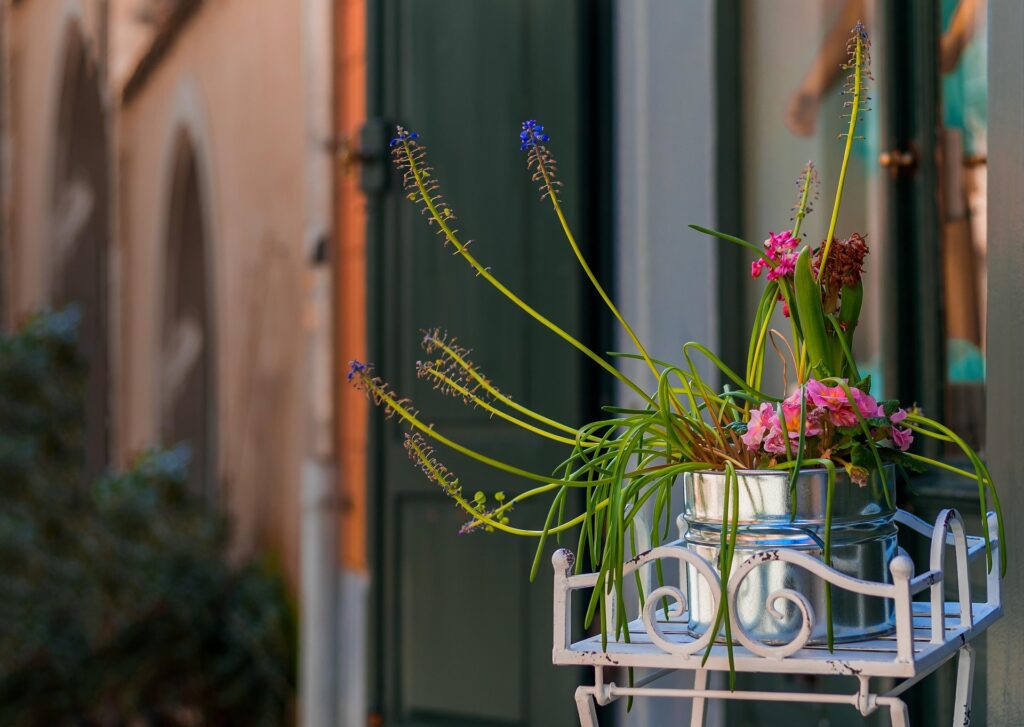
Color-enhanced bark mulches use organic dyes or iron-based colorants that don’t fade quickly in Florida’s intense sunlight. Some formulations include reflective particles that help reduce soil temperature while maintaining an attractive appearance throughout the growing season.
These aesthetic improvements help bark mulches maintain their visual appeal when used in Florida patio plants and decorative container displays.
The water conservation mechanism in quality bark mulch works through multiple layers of protection. The mulch surface reflects some solar radiation while absorbing and slowly releasing moisture from rainfall or irrigation.
The air spaces between bark pieces create insulation that moderates soil temperature fluctuations. As the mulch gradually decomposes, it adds organic matter that improves soil water-holding capacity.
Living Mulch
Living mulch alternatives represent an innovative approach that combines ground cover plants with traditional mulching benefits. These systems use low-growing, spreading plants that create living carpets around container plants, providing moisture conservation, temperature moderation, and aesthetic beauty.
Popular choices for Florida container gardening include native species like sunshine mimosa, beach sunflower, or non-native options like sweet alyssum and portulaca.
Living mulch systems work through transpiration regulation and microclimate modification. The ground cover plants create humidity microclimates around container bases while their root systems help stabilize soil moisture levels.
Some living mulches also provide nitrogen fixation (leguminous species) or pest deterrent properties (aromatic herbs) that benefit the main container plants.
These systems excel in large container installations, permanent plantings, and decorative applications where visual appeal is important alongside functional benefits.
They’re particularly valuable for Florida native container plants where native ground covers can create authentic ecosystem relationships that improve overall plant health and resilience.
However, living mulch systems require more complex management than traditional mulches, including pruning, fertilization, and potential competition management with main plants.
They may also harbor beneficial insects but could potentially provide habitat for pest species in some situations.
Living mulch plants can be sourced from native plant nurseries, with costs varying widely based on species selection and container size requirements.
Smart Watering Systems and Tools for Florida Gardeners
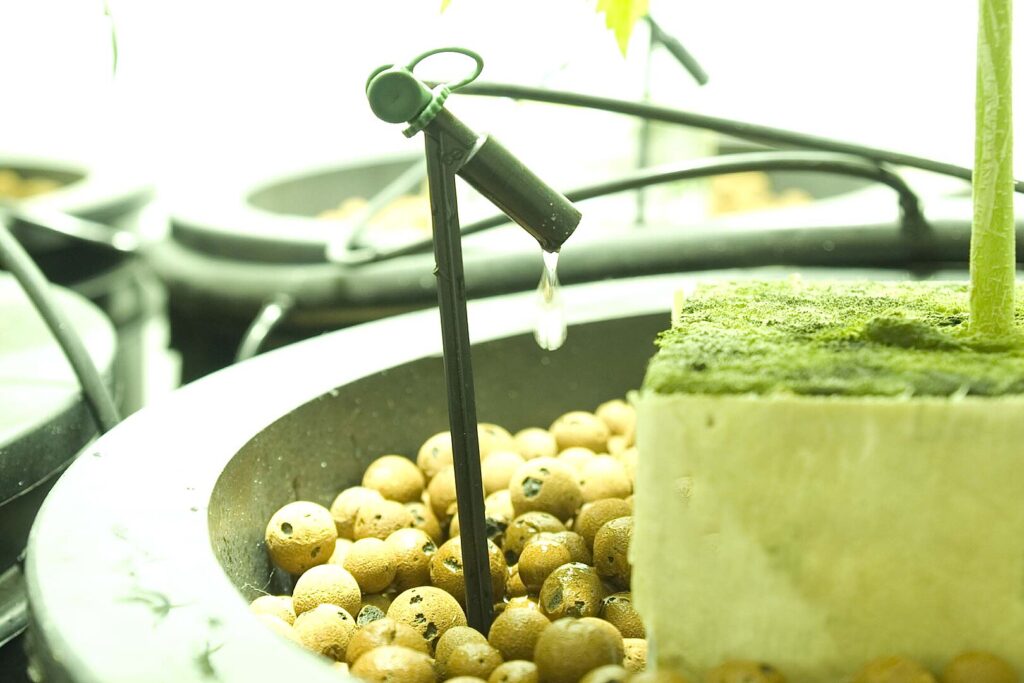
Modern container gardening innovations have revolutionized how Florida gardeners manage watering container gardens.
These smart watering systems combine technology with practical designs to create efficient, automated solutions that address Florida’s unique climate challenges while reducing water waste and maintenance time.
Drip Irrigation Setup for Container Gardens
Drip irrigation systems provide the most efficient water delivery for Florida container gardening. They deliver precise amounts of water directly to root zones while minimizing evaporation losses.
These systems excel in Florida’s hot climate by reducing water waste and preventing fungal diseases associated with overhead watering.
Automatic drip irrigation watering kits offer an excellent entry-level solution for Florida container gardeners. Many can water multiple plants with a simple installation process.
Troubleshooting Common Watering Problems in Florida
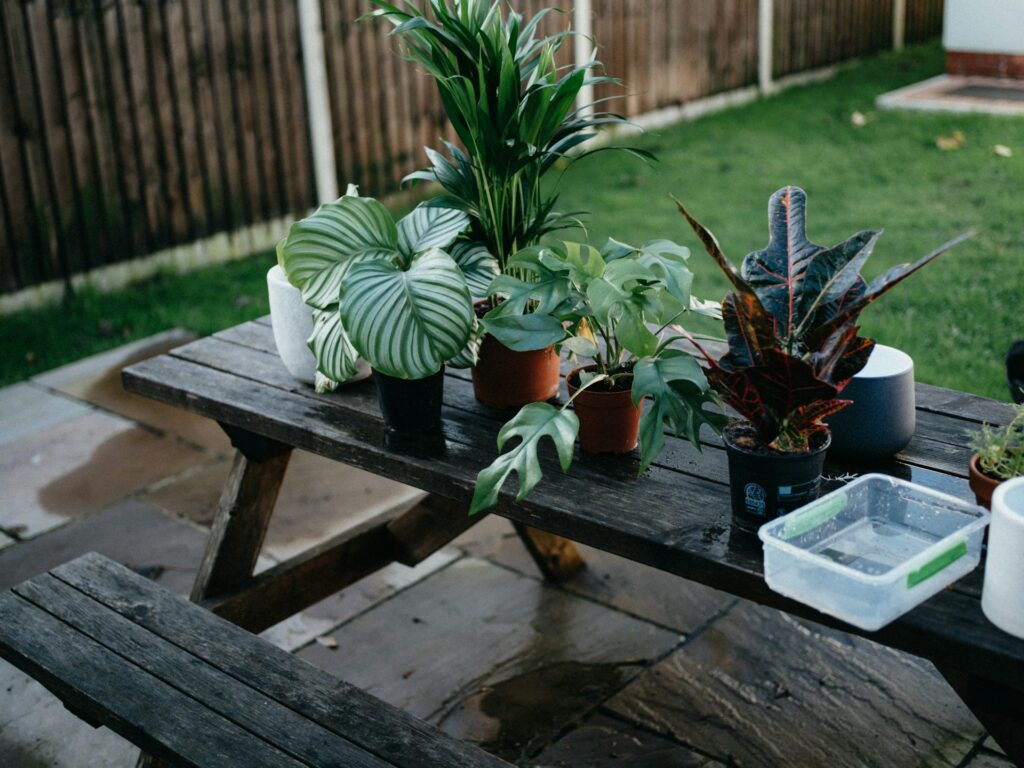
Florida container gardening presents unique challenges that can quickly turn thriving plants into struggling specimens.
Understanding how to diagnose and correct watering container plants florida problems is essential for maintaining healthy container gardens in the Sunshine State’s demanding climate.
Signs of Overwatering vs. Underwatering in Container Plants
Distinguishing between overwatering vs underwatering symptoms is crucial for Florida container plant care, as both conditions can appear deceptively similar and often occur within days of each other due to Florida’s variable weather patterns.
Overwatering Symptoms and Diagnosis
Overwatering container plants in Florida’s humid climate creates ideal conditions for root rot and fungal diseases. The warm, moist environment accelerates plant decline, making early detection critical for recovery.
Primary overwatering indicators:
- Yellowing leaves from the bottom up – Unlike nutrient deficiencies that affect older leaves first, overwatering yellowing begins with the newest leaves and progresses upward
- Soft, mushy stems at soil level – Gently squeeze the base of the plant; healthy stems feel firm, while overwatered plants feel spongy
- Fungal growth on soil surface – White, fuzzy mold or mushrooms appearing in containers indicate excessive moisture
- Foul odor from soil – Smell the growing medium; healthy soil has an earthy scent, while overwatered soil smells sour or rotten
- Wilting despite moist soil – Plants appear droopy even when soil feels wet to the touch
Advanced diagnostic techniques:
- Root inspection method: Carefully remove the plant from its container and examine roots. Healthy roots appear white or light-colored and feel firm. Overwatered roots turn brown or black, feel mushy, and may fall apart when touched.
- Soil drainage test: Pour water onto the soil surface and time how long it takes to disappear. Well-draining container soil should absorb water within 5-10 minutes. Longer absorption times indicate drainage problems.
- Container weight assessment: Lift the container before and after watering to establish baseline weights. Consistently heavy containers between waterings suggest poor drainage or overwatering.
Underwatering Symptoms and Identification
Underwatering container plants in Florida’s intense heat can cause rapid plant decline, especially during summer months when container plant heat stress compounds moisture deficiency problems.
Primary underwatering indicators:
- Leaf wilting and curling – Leaves fold inward or curl at edges to reduce surface area exposed to sun
- Dry, brittle leaf texture – Leaves feel papery and may crackle when touched
- Soil shrinkage – Growing medium pulls away from container sides, creating gaps
- Rapid water absorption – Water disappears immediately when poured onto soil surface
- Stunted growth – New growth appears smaller and weaker than normal
Comprehensive underwatering assessment:
- Finger depth test: Insert your finger 2-3 inches deep into soil in multiple locations. Consistently dry soil at this depth indicates underwatering.
- Wooden dowel method: Push a clean wooden dowel or skewer to the container bottom, leave for 30 seconds, then remove. Dry wood indicates insufficient moisture throughout the root zone.
- Plant response timing: Note how quickly plants perk up after watering. Underwatered plants typically recover within 2-4 hours, while overwatered plants remain droopy.
Distinguishing Between Similar Symptoms
Critical differentiation techniques:
- Soil moisture correlation: Always check soil moisture when observing plant symptoms. Wilting with wet soil suggests overwatering; wilting with dry soil indicates underwatering.
- Leaf texture differences: Overwatered leaves feel soft and may be slightly thicker; underwatered leaves feel crispy and thin.
- Recovery patterns: Underwatered plants recover quickly after proper watering; overwatered plants require drainage improvements and may need weeks to recover.
Dealing with Root Rot in Florida’s Humid Conditions
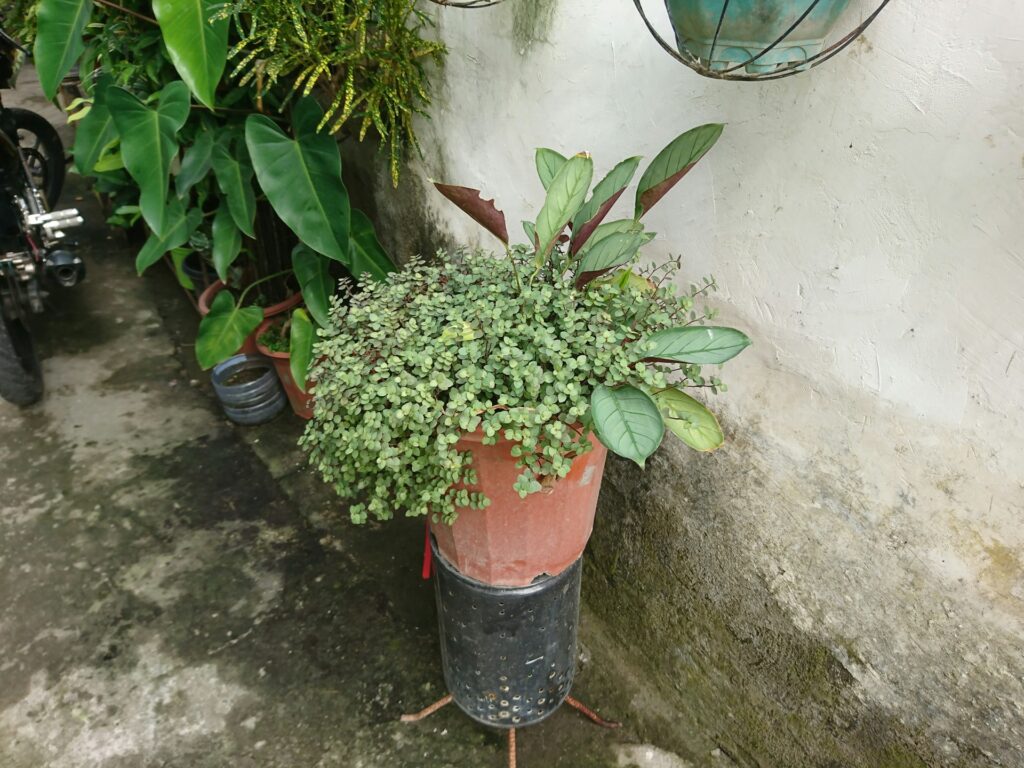
Container plant root rot florida poses a serious threat in the state’s warm, humid climate where fungal and bacterial pathogens thrive. Quick action can save affected plants, but prevention remains the best strategy.
Root Rot Identification and Assessment
Comprehensive root rot diagnosis:
- Visual inspection protocol: Remove the plant from its container and gently shake off loose soil. Healthy roots appear white, cream, or light brown with firm texture. Diseased roots turn dark brown or black and feel mushy or slimy.
- Smell test verification: Healthy roots have minimal odor or smell slightly earthy. Root rot produces a distinct foul, rotten smell that intensifies when roots are disturbed.
- Extent evaluation: Assess what percentage of the root system shows damage. Plants with less than 50% root damage have good recovery chances; those with more extensive damage may not survive.
Emergency Root Rot Treatment Protocol
Step-by-step root rot intervention:
Phase 1: Immediate Assessment (Day 1)
- Remove from container and photograph root system for reference
- Rinse roots gently with lukewarm water to remove soil and examine damage extent
- Sterilize cutting tools with 70% isopropyl alcohol or 10% bleach solution
- Cut away diseased roots using sharp, sterile pruning shears, removing all brown, black, or mushy portions
Phase 2: Treatment Application (Day 1-2)
- Apply fungicide treatment: Soak remaining healthy roots in fungicide solution (copper sulfate or biological fungicides like Bacillus subtilis) for 15-30 minutes
- Prepare new growing medium: Use fresh, sterile potting mix with enhanced drainage – add 25% perlite or coarse sand to standard potting soil
- Sanitize container with 10% bleach solution, rinse thoroughly, and allow to dry completely
Phase 3: Replanting and Recovery (Day 2-14)
- Replant in a smaller container if root loss exceeds 30% – reduced root systems cannot support large containers
- Water carefully – provide just enough moisture to keep soil slightly damp, never soggy
- Relocate to partial shade for 2-3 weeks to reduce transplant stress
- Monitor daily for new growth and signs of recurring problems
Root Rot Prevention Strategies
Long-term prevention protocols:
- Improve drainage permanently: Add drainage holes to containers, use drainage layers of gravel or pottery shards, and elevate containers on pot feet or bricks
- Modify watering technique: Switch to bottom watering or use drip irrigation to prevent water sitting on soil surface
- Enhance air circulation: Space containers adequately and use fans during humid periods
- Apply preventive treatments: Monthly soil drenches with beneficial microorganisms (mycorrhizal fungi, Trichoderma) help suppress pathogenic fungi
Managing Water Stress During Heat Waves and Drought Periods
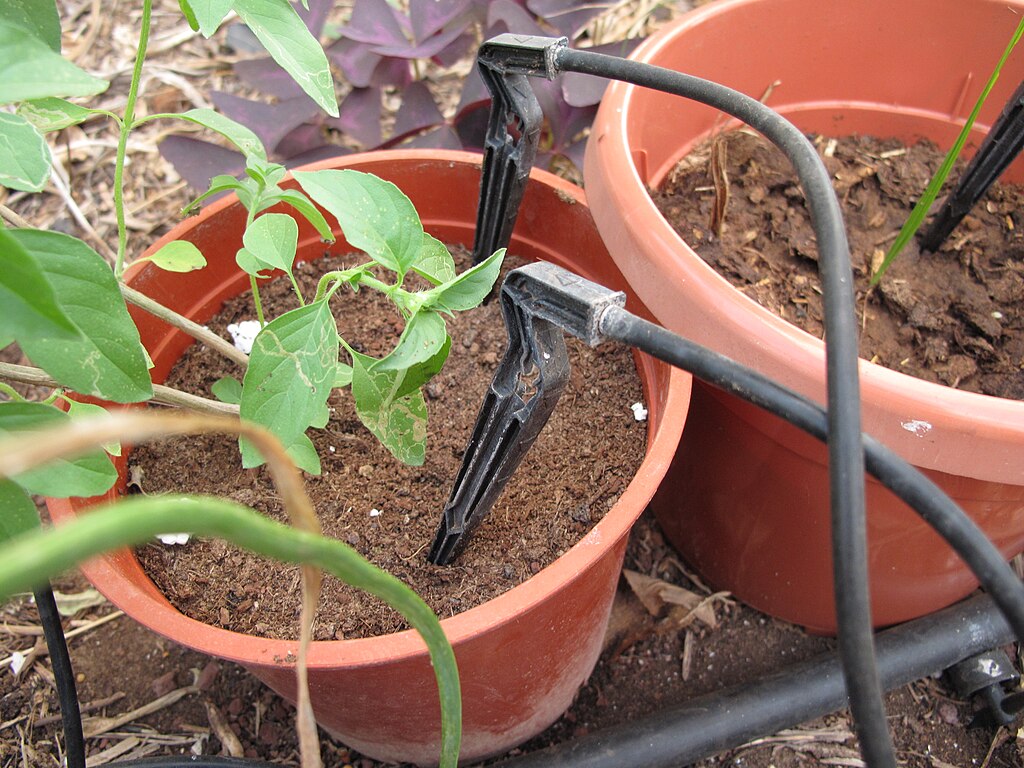
Florida heat waves can push container plant water requirements beyond normal irrigation capabilities, requiring emergency protocols to prevent plant loss during extreme weather events.
Heat Wave Preparation and Response
Pre-heat wave preparation (48 hours before forecast high temperatures):
- Deep watering protocol: Water all containers thoroughly until drainage occurs, ensuring complete root zone saturation
- Mulch application: Apply 2-3 inches of organic mulch or reflective mulch to all container surfaces to reduce evaporation
- Relocation strategy: Move containers to locations receiving morning sun but afternoon shade (east-facing areas ideal)
- Grouping for humidity: Cluster containers together to create beneficial microclimates with higher humidity
Active heat wave management:
- Morning watering routine (5:00-7:00 AM): Check all containers and provide supplemental water to any showing stress signs
- Midday monitoring (11:00 AM-2:00 PM): Inspect plants for wilting and provide emergency water to severely stressed specimens
- Evening recovery assessment (6:00-8:00 PM): Evaluate plant condition and provide additional water if needed
Emergency cooling techniques:
- Misting systems: Use fine spray nozzles to create cooling mist around (not on) plant foliage during the hottest periods
- Shade cloth installation: Deploy 30-50% shade cloth over container areas during peak heat hours (10 AM – 4 PM)
- Evaporative cooling: Place water-filled saucers around containers to increase local humidity through evaporation
Drought Period Management
Extended drought protocols for Florida container gardening:
Week 1-2: Conservation Phase
- Prioritize plant categories: Focus water on essential edibles and expensive specimens first
- Implement water recycling: Collect air conditioning condensate, dehumidifier water, and initial shower water for container irrigation
- Reduce plant stress: Remove flowers and developing fruits to redirect energy to survival rather than reproduction
Week 3-4: Intensive Care Phase
- Assess plant viability: Make tough decisions about which plants to continue supporting
- Implement survival watering: Provide minimal water (just enough to prevent permanent wilting) to selected plants
- Prepare for recovery: Order replacement plants for post-drought planting
Water Stress Recovery Protocols
Post-stress recovery management:
- Gradual rehydration: Avoid flooding stressed plants with excessive water immediately after stress periods
- Gentle feeding: Apply diluted liquid fertilizer (25% strength) to help plants recover energy reserves
- Pruning assessment: Remove dead or severely damaged foliage to redirect plant energy to healthy growth
- Monitoring intensification: Check plants twice daily for 2-3 weeks to catch recurring stress early
Addressing Salt Buildup from Hard Water or Fertilizers
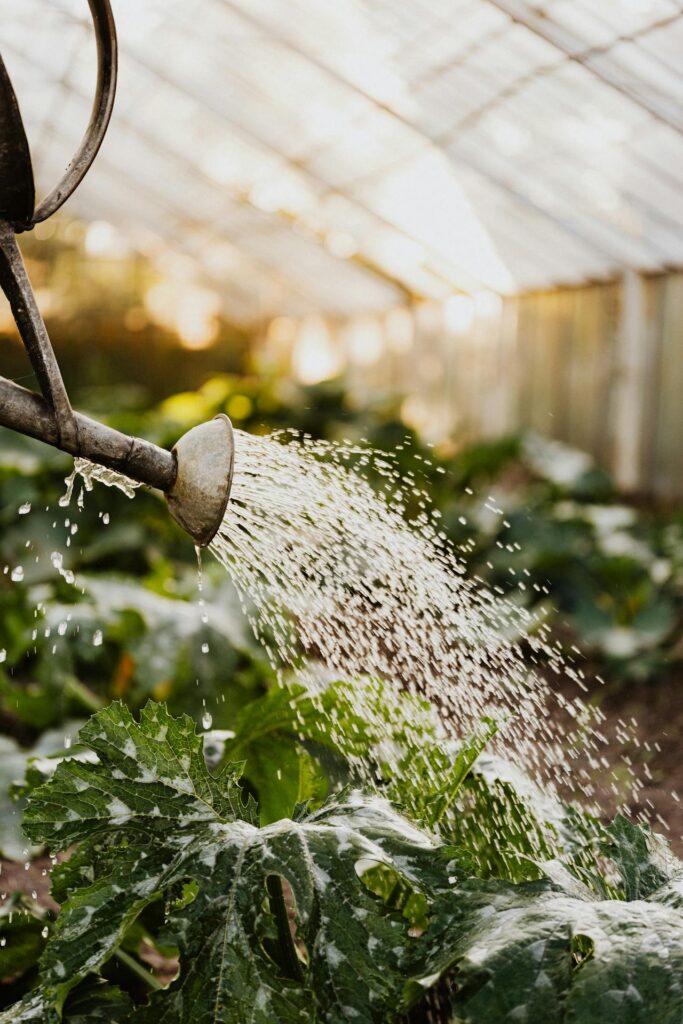
Salt buildup in container plants presents a significant challenge in Florida container gardening, where hard water, frequent fertilization, and rapid evaporation concentrate mineral salts to toxic levels.
Salt Buildup Identification
Visual indicators of salt accumulation:
- White, crusty deposits on soil surface, container rims, or exterior walls
- Leaf edge browning (leaf scorch) starting with tips and progressing inward
- Stunted growth despite adequate water and nutrition
- Plant wilting even with moist soil, caused by roots’ inability to absorb water due to high soil salinity
Scientific salt level assessment:
- EC meter testing: Use electrical conductivity meters to measure soil salinity. Readings above 2.0 mS/cm indicate problematic salt levels for most container plants
- TDS testing: Total dissolved solids meters provide approximations of salt content. Levels exceeding 1400 ppm suggest intervention needed
- Soil pH correlation: High salt buildup often correlates with elevated soil pH levels above 7.5
Salt Removal Techniques
Comprehensive salt flushing protocol:
Phase 1: Assessment and Preparation
- Test baseline levels using EC meter or TDS pen to quantify salt concentration
- Prepare flushing water: Use distilled water, rainwater, or reverse osmosis water with low mineral content
- Calculate water volumes: Plan to use 3-4 times the container volume for effective flushing
Phase 2: Active Salt Flushing
- Initial gentle watering: Apply water slowly to prevent soil compression and ensure even penetration
- Deep saturation: Continue watering until water flows freely from drainage holes for 5-10 minutes
- Drainage period: Allow 30-60 minutes for complete drainage before second flush
- Repeat flushing: Perform 2-3 complete flush cycles to remove accumulated salts effectively
Phase 3: Post-Flush Management
- Test reduction success: Re-measure EC or TDS levels to confirm salt reduction
- Soil amendment: Add organic matter like compost to improve soil buffering capacity
- Fertilizer adjustment: Switch to low-salt fertilizers and reduce application frequency
Preventing Future Salt Accumulation
Long-term salt prevention strategies:
- Water quality improvement: Install water softeners or use collected rainwater for irrigation when possible
- Fertilizer modifications: Choose low-salt index fertilizers and apply at 50% recommended rates more frequently
- Routine flushing: Perform monthly salt flushing during the growing season, using 1.5 times the container volume of low-mineral water
- Mulching benefits: Organic mulches help moderate soil temperature and reduce evaporation that concentrates salts
Reviving Wilted or Stressed Container Plants
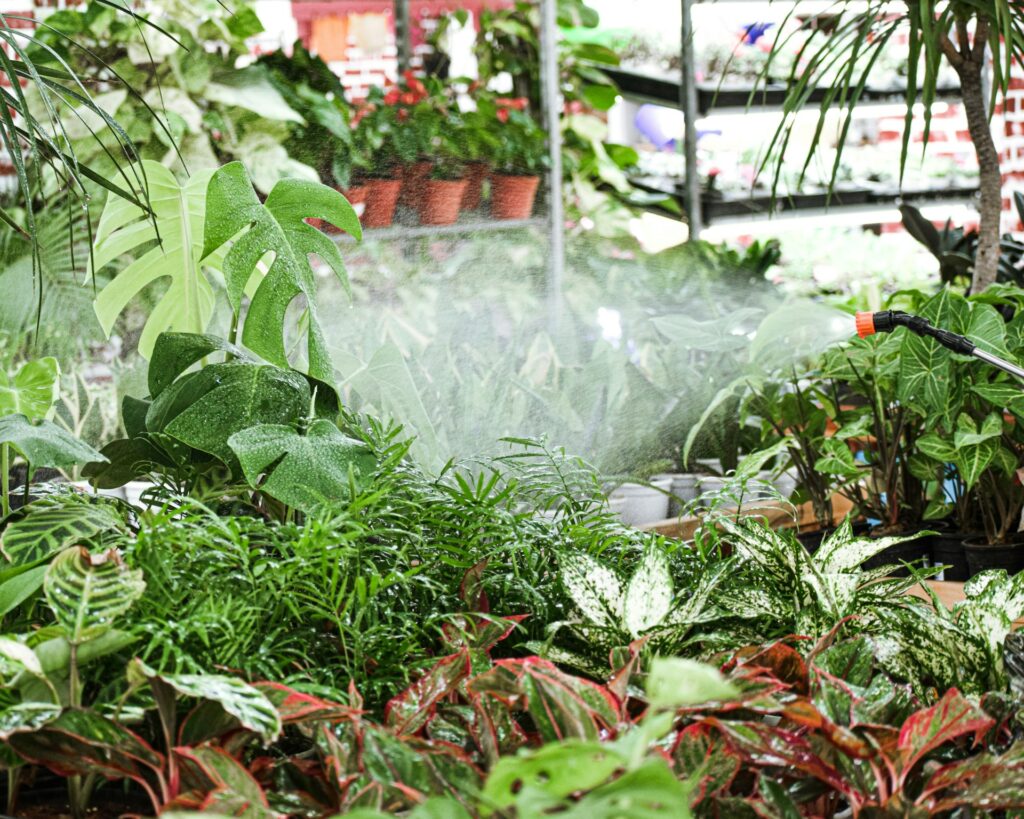
Reviving stressed plants requires systematic diagnosis and treatment approaches tailored to Florida container gardening where multiple stress factors often compound simultaneously.
Emergency Plant Revival Protocol
Immediate assessment and triage (First 30 minutes):
- Stress factor identification: Check soil moisture, examine for pests, assess heat exposure, and evaluate container drainage
- Severity classification:
- Mild stress: Some wilting but stems remain firm
- Moderate stress: Significant wilting with some stem softness
- Severe stress: Complete wilting with stem collapse
Rapid intervention techniques:
Dehydration stress:
- Gradual rehydration: Place container in tray of lukewarm water, allowing soil to absorb moisture from bottom up over 30-60 minutes
- Tent method: Create temporary shade using cardboard or cloth while plant recovers
- Humidity enhancement: Place wet towels or water-filled saucers around container to increase local humidity
Heat stress recovery:
- Immediate cooling: Move to the shadiest available location, avoiding sudden temperature changes
- Gentle misting: Lightly mist air around plant (not directly on foliage) to reduce ambient temperature
- Root cooling: Place container in shallow pan of cool water for 15-20 minutes
Multiple stress factors:
- Address most critical first: Prioritize water stress before heat, nutrient deficiency before pest issues
- Staged recovery: Implement one intervention at a time, monitoring plant response before adding treatments
- Support systems: Provide physical support (stakes) for plants with weakened stems
Recovery Monitoring and Long-term Care
Daily monitoring checklist (First 2 weeks):
- Morning assessment: Check overnight recovery, note new growth signs
- Midday evaluation: Monitor stress recurrence during peak heat
- Evening review: Assess overall plant condition and response to treatments
Progressive care modifications:
- Week 1: Focus on basic survival needs (water, shade, protection)
- Week 2-3: Gradually return to normal light conditions, begin gentle fertilization
- Week 4+: Resume standard care routine with enhanced monitoring
Recovery success indicators:
- New growth emergence: Fresh leaves or shoots appearing within 7-14 days
- Improved turgor pressure: Leaves feel firm and stand upright without support
- Root activity: White root tips visible in drainage holes or when gently lifted
- Color improvement: Yellowed foliage begins showing green coloration
Seasonal Watering Strategies Throughout the Florida Year
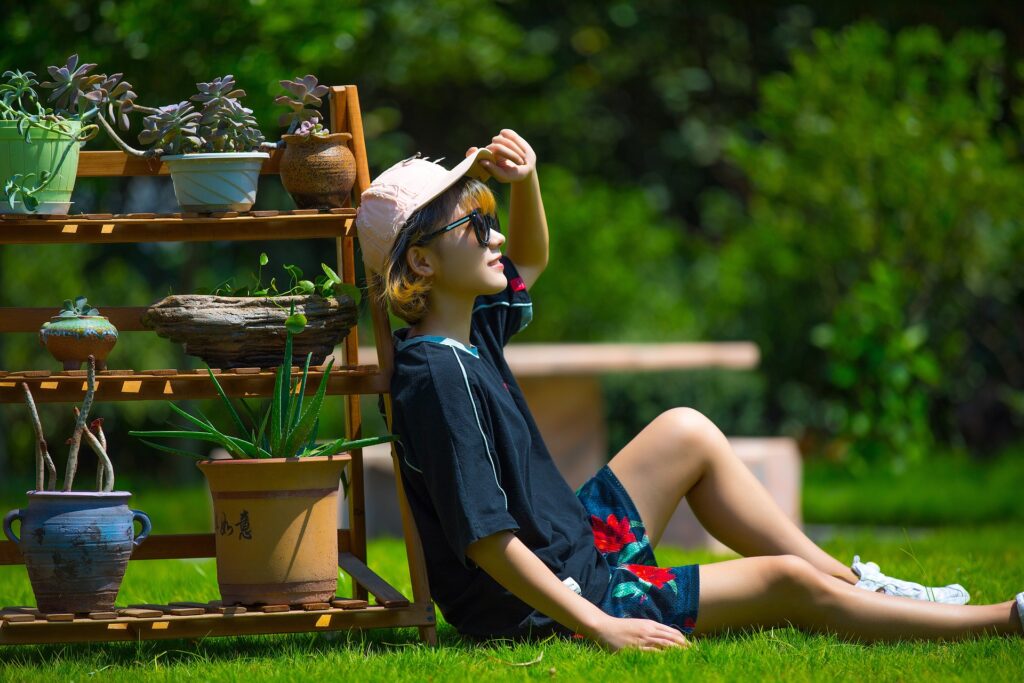
Florida gardening seasons operate differently from traditional four-season climates, requiring specialized seasonal watering strategies that align with the state’s distinct wet and dry periods.
Understanding how to adjust watering container plants in Florida throughout the year is essential for maintaining healthy container gardens in the Sunshine State’s unique climate patterns.
Spring Watering as Plants Emerge from Winter Dormancy
Florida spring gardening begins earlier than most regions, often starting in February when temperatures consistently reach the 60s and plants begin active growth.
This transition period requires careful attention to changing container plant water requirements as metabolism increases and root activity resumes.
March signals the end of Florida’s dry season and the beginning of increased plant activity. When soil consistently reaches 65°F, root activity accelerates significantly and plants will show new growth indicators like swelling buds and emerging leaves.
April represents peak spring growing conditions with warm days, cool nights, and moderate humidity. This period offers ideal conditions for establishing Florida container vegetables and herbs. Apply deep watering in the morning when evaporation rates remain low but plants can utilize moisture throughout the day.
Combine watering with liquid fertilizer applications as plants enter active growth phases. Increase air circulation between pots as humidity rises to prevent fungal issues.
May serves as preparation for summer’s intensity, with increasing temperatures and humidity signaling the approaching wet season. Florida container gardening requires proactive adjustments during this critical transition month as plants prepare for the challenges ahead.
Weather Tracking for Spring Success
- Monitor weather forecasts to prepare for any late-season cold snaps
- Monitor soil moisture as spring rains can be unpredictable, even non-existant
- Watch humidity trends that affect evaporation rates and disease pressure
Summer Survival Techniques During Peak Heat and Storms
Watering container plants in summer in Florida presents the year’s greatest challenges, combining intense heat, high humidity, frequent thunderstorms, and the active hurricane season from June through November.
June marks the official start of Florida’s wet season, but early storms may be sporadic, requiring vigilant container plant heat stress management during days exceeding 90°F.
Establish a morning routine of inspecting all containers before temperatures climb. Provide deep watering to any showing stress. Keep watering supplies readily available for plants showing severe wilting during peak heat. Conduct evening recovery assessments to evaluate plant condition and provide supplemental water as needed.
July and August typically bring daily afternoon thunderstorms along with the highest temperatures and humidity levels of the year. Florida garden containers must handle both drought and flood conditions within the same day.
Check containers in early morning before potential afternoon storms. Use weather radar apps to time watering around approaching storms. Inspect drainage after storms to adjust evening watering based on actual rainfall received.
Summer Weather Management
- Track heat index effects that combine temperature and humidity impacts on plant stress
- Use radar and precipitation forecasts to time watering around afternoon thunderstorms
- Follow tropical weather developments throughout hurricane season
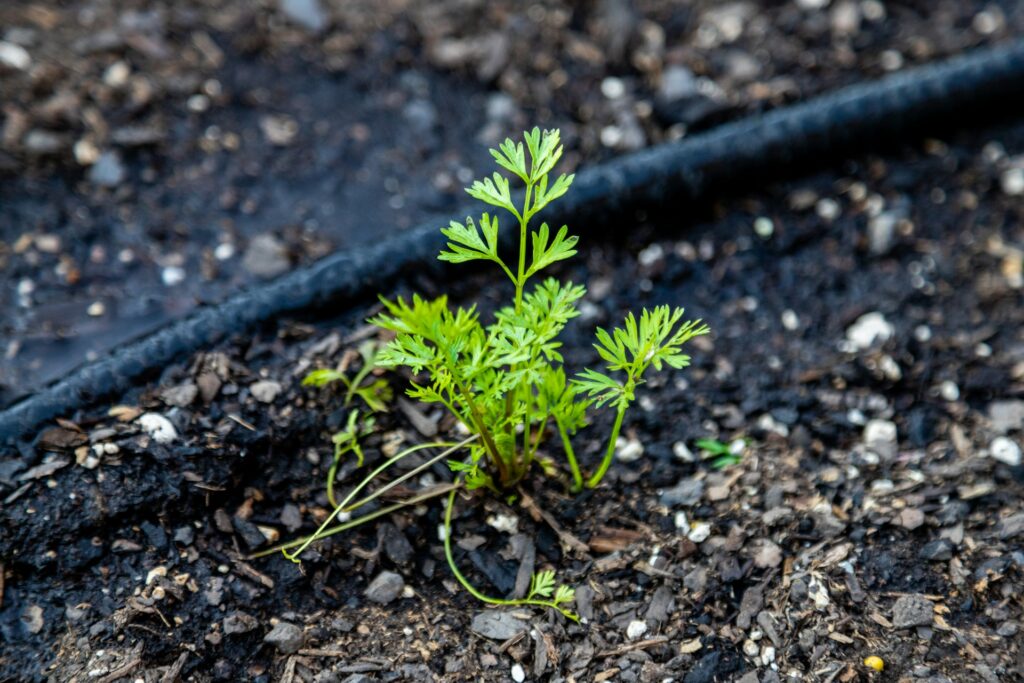
Fall Transition and Preparation for Cooler Months
Florida fall gardening begins subtly in September as humidity decreases and afternoon storms become less frequent. The seasonal watering strategies during this period focus on transitioning plants toward the dry season while taking advantage of optimal growing conditions.
September often brings some of Florida’s most pleasant weather, with reduced humidity and fewer afternoon storms. This period is ideal for establishing new container plants before winter arrives.
Begin extending time between waterings as humidity drops and evaporation rates decrease. Monitor container microclimates since plants in full sun locations may still require daily watering, while those in partial shade need less frequent irrigation.
October represents peak planting season for cool-season crops and Florida container vegetables like lettuce, broccoli, and herbs that thrive in cooler temperatures.
Newly planted containers require daily monitoring and frequent light watering until established. Mature plants can typically handle every-other-day watering schedules.
Cool-season vegetables often need more consistent moisture than summer crops adapted to dry periods.
November begins Florida’s official dry season, characterized by lower humidity, infrequent rainfall, and occasional cold fronts that can drop temperatures significantly overnight.
This marks the transition back to more conservative watering practices as natural rainfall decreases.
Fall Weather Pattern Recognition
- Record actual precipitation amounts to adjust irrigation schedules as natural rainfall decreases
- Track humidity levels to predict evaporation rates and adjust watering frequency
Winter Watering Adjustments for Florida’s Mild Season
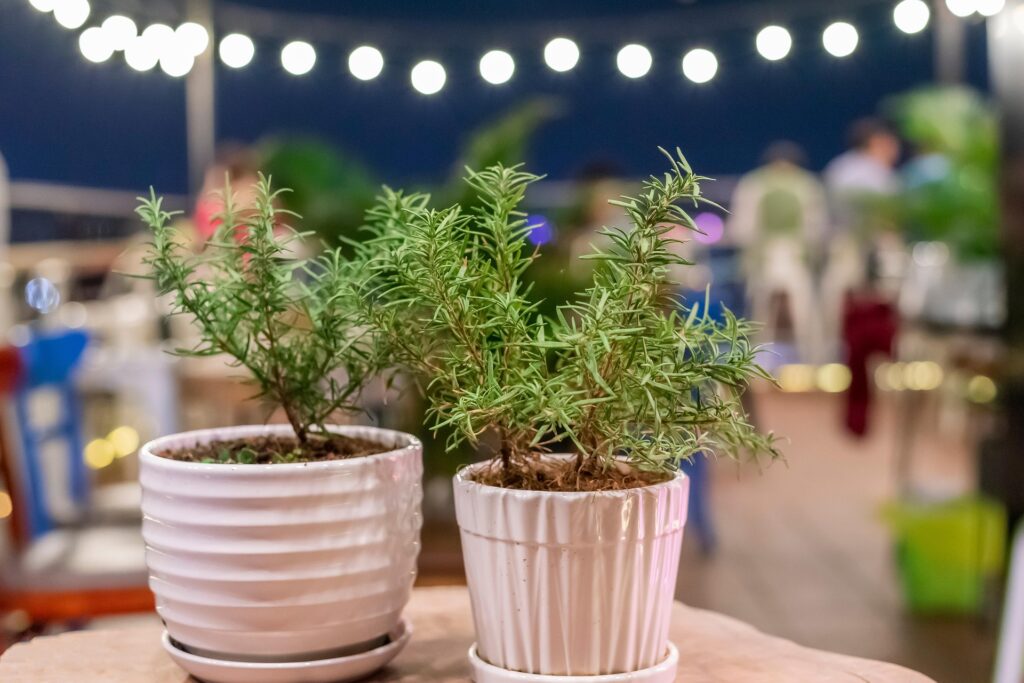
Florida winter gardening presents unique challenges as temperatures fluctuate dramatically, humidity drops to annual lows, and rainfall becomes sporadic.
Watering container plants during this season requires understanding that “winter” in Florida means dry season rather than dormancy.
December typically brings the driest conditions of the year combined with occasional cold snaps that can stress container plants through both dehydration and temperature shock.
Apply water thoroughly 2-3 times per week rather than daily light applications. Time watering for mid-morning to allow plants to absorb moisture before potential overnight cold.
Combine watering with cold protection measures like frost cloths or temporary shelters when needed.
January and February present the greatest temperature variability, with potential freezes followed by warm, dry periods that quickly dehydrate container plants.
Water containers thoroughly the day before predicted freezes to help plants withstand cold stress. Check for freeze damage afterward and adjust watering for damaged plants that may have altered water needs.
Resume normal watering schedules quickly when temperatures return to normal ranges.
Move containers to south-facing locations that receive maximum winter sun exposure. Shield containers from drying winter winds that can quickly dehydrate plants. Group containers near buildings or other structures that provide heat retention.
Reduce watering frequency for dormant tropical plants to prevent root rot during low-growth periods. Increase attention to vegetables and herbs that thrive in winter conditions. Allow Florida native container plants to experience natural dry season conditions while monitoring for excessive stress.
Winter Weather Vigilance
- Set up alerts for temperatures dropping below 35°F to protect container plants
- Track cold, dry winds that rapidly dehydrate container plants
- Monitor daily sunshine hours that affect winter plant water needs
Recommended Weather Tracking Methods for Florida Gardeners
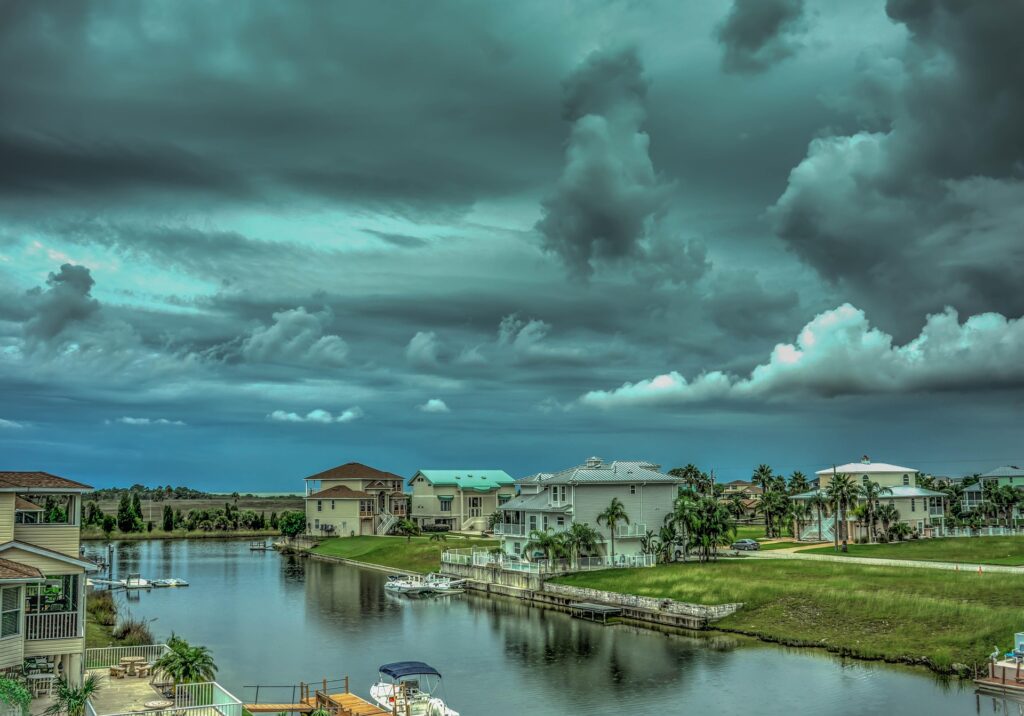
Advanced weather monitoring forms the foundation of successful seasonal watering strategies. These tools provide the data needed to make informed irrigation decisions throughout Florida’s variable climate patterns.
Professional Weather Resources
Florida Automated Weather Network (FAWN) provides real-time agricultural weather data from over 40 stations across Florida. Access FAWN through their main website at fawn.ifas.ufl.edu.
The website shows a map of Florida with current temperature readings from all weather stations. It’s mobile-friendly and requires no account signup. You can view current conditions, access historical data, and use agricultural decision-making tools completely free. The data updates every 15 minutes.
National Weather Service offices serve different regions of Florida. Access the Miami office at weather.gov/mfl for South Florida, Tampa office at weather.gov/tbw for West Central Florida, Jacksonville office at weather.gov/jax for North Florida, and Melbourne office at weather.gov/mlb for East Central Florida. Each office provides region-specific forecasts, severe weather warnings, and marine forecasts.
University of Florida Extension offers county-specific gardening alerts and weather advisories. Find your local extension office at sfyl.ifas.ufl.edu/find-your-local-office and sign up for their newsletters and alerts. Many counties offer email lists specifically for agricultural and gardening weather alerts.
Last but not least, Tampa Bay gardeners can follow Denis Phillips, known to be one of the most accurate and helpful meteorologists in Florida (if not the country).
Technology Integration and Apps
Mobile Weather Applications provide essential real-time data through smartphone apps. Download Weather Underground from your device’s app store for hyperlocal forecasts with user-submitted weather reports.
AccuWeather offers detailed hourly forecasts and severe weather alerts with customizable push notifications.
The Weather Channel app provides radar maps and precipitation forecasts essential for timing irrigation around natural rainfall.
Apple Weather offers precise precipitation timing predictions for iOS users.
Data Logging and Pattern Recognition
Manual Documentation Methods require no technology beyond basic tools. Maintain garden journals or use traditional paper notebooks.
Create digital spreadsheets using Microsoft Excel, Google Sheets, or Apple Numbers to track daily temperatures, rainfall amounts, humidity levels, and irrigation applications.
Use your smartphone’s camera for photo documentation of plant conditions, organizing images by date to correlate with weather data over time.
Emergency Weather Response Systems
Alert Configuration ensures you receive timely warnings through multiple channels. Set up severe weather notifications by enabling push notifications in weather apps and sign up for National Weather Service alerts at weather.gov/subscribe for email and text warnings.
Configure threshold monitoring by creating custom alerts in weather apps when humidity drops below 30% or temperatures exceed 95°F. Establish rainfall tracking notifications for daily amounts above 1 inch through apps like Weather Underground or personal weather station apps.
These comprehensive weather tracking methods provide Florida container gardeners with the tools and knowledge needed to anticipate weather challenges and adjust strategies for watering container plants proactively throughout the year.
The Art of Watering Container Plants
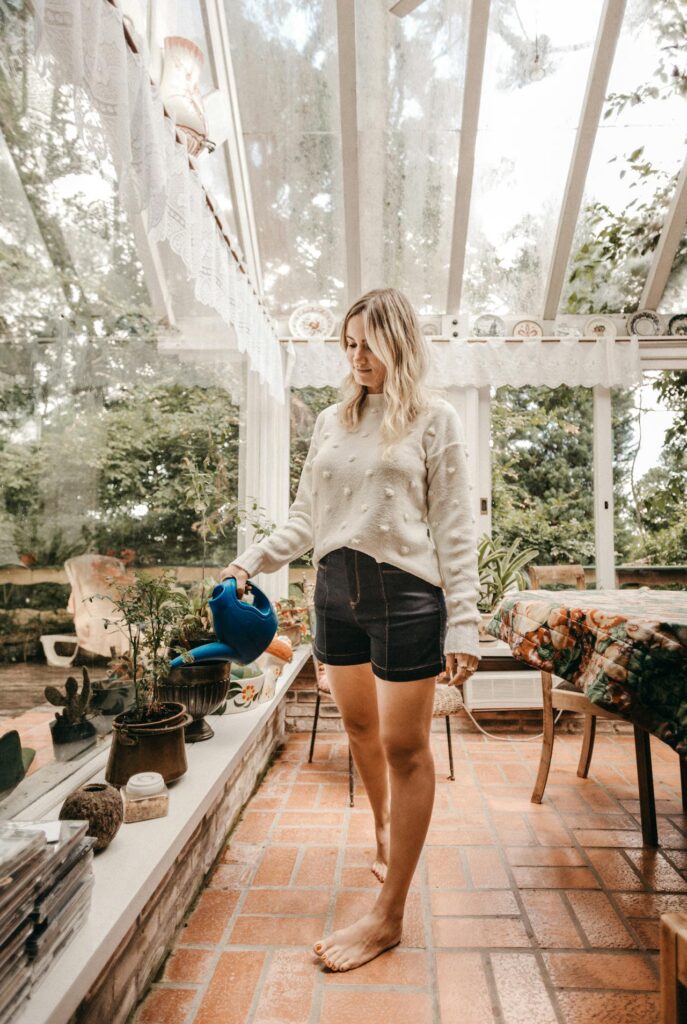
Mastering the art of watering container plants in Florida doesn’t have to feel like solving a complex puzzle! By understanding your local climate conditions, choosing appropriate containers and soil mixes, and implementing the right watering techniques for your specific plants, you’ll create a thriving container garden that can weather any storm.
Remember, successful container gardening in Florida is all about finding that sweet spot between providing adequate moisture and preventing waterlogged roots. Start by implementing one or two techniques from this guide, observe how your plants respond, and gradually build your confidence and expertise.
Ready to transform your container garden into a Florida success story? Begin by assessing your current setup and identifying which plants need the most attention. Your future self – and your plants – will thank you for taking action today!
Last update on 2025-08-06 / Affiliate links / Images from Amazon Product Advertising API
This product presentation was made with AAWP plugin.




















